

“…the great state University of Wisconsin should ever encourage that continual and fearless sifting and winnowing by which alone the truth can be found.” University of Wisconsin-Madison Since 1892 dailycardinal.com Thursday, February 22, 2024 l GRAPHIC BY LIAM BERAN/THE DAILY CARDINAL WISCONSIN’S FASCIST HISTORY
neo-Nazi intrusions resurface Wisconsin's century-old history with hate and exclusion
Recent

DemocraticGov.TonyEverssignedintolawMondaynew AssemblyandSenatedistrictsaheadofWisconsin’s2024election.
By Ava Menkes STATE NEWS EDITOR
Democratic Gov. Tony Evers passed a new plan Monday to redraw Wisconsin’s legislative districts ahead of the upcoming election, changing the political landscape of the state for the next decade.
This decision follows the Republican-controlled Legislature’s vote to pass his proposal last Tuesday.
“Today is a beautiful day in Wisconsin,” Evers said. “I made a promise to the people of Wisconsin, I would always try to do the right thing, and keeping that promise to me matters most, even if members of my own party disagree with me,” he said.
In December, the Wisconsin Supreme Court’s 4-3 liberal majority ruled the state’s legislative maps were unconstitutional because districts are not contiguous, meaning all parts of a voting district were not physically in contact.
In January, state lawmakers, petitioners and Evers submitted their new legislative maps to the court. The maps would have reduced Republican advantage in Wisconsin.
Assembly Speaker Robin Vos, R-Rochester, said in a statement Monday the new maps are “the most” Republican-leaning option out of what was submitted.
Vos said he believes Republicans can still win competitively because they “have the better policy.”
“We are happy that the Governor’s signature brings to an end decades of liberal special interest litigation over maps in Wisconsin,” he said.
Additionally, Senate Majority Leader Devin LeMahieu, R-Oostburg, told WISN 12 News Sunday that Republicans do not have ulterior motives to sue the decision and keep it in the courts.
“We can sue regardless of anything, but I don’t know how you sue when there’s not a decision,” LeMahieu said.
Currently, Republicans hold a 64-35 majority in the Assembly and a 22-11 supermajority in the Senate.
Under the maps submitted by Evers, Democrats could secure control of the Senate and Assembly if they perform similarly to how Evers did in his 2022 re-election.
If Democrats get margins similar to the party’s loss against U.S. Sen. Ron Johnson in 2022, Republicans would control the Assembly 51-48 and the Senate 17-16, according to the Cap Times.
All members of the Assembly and state senators in even-numbered districts will run in redrawn districts in 2024. State senators in odd-numbered
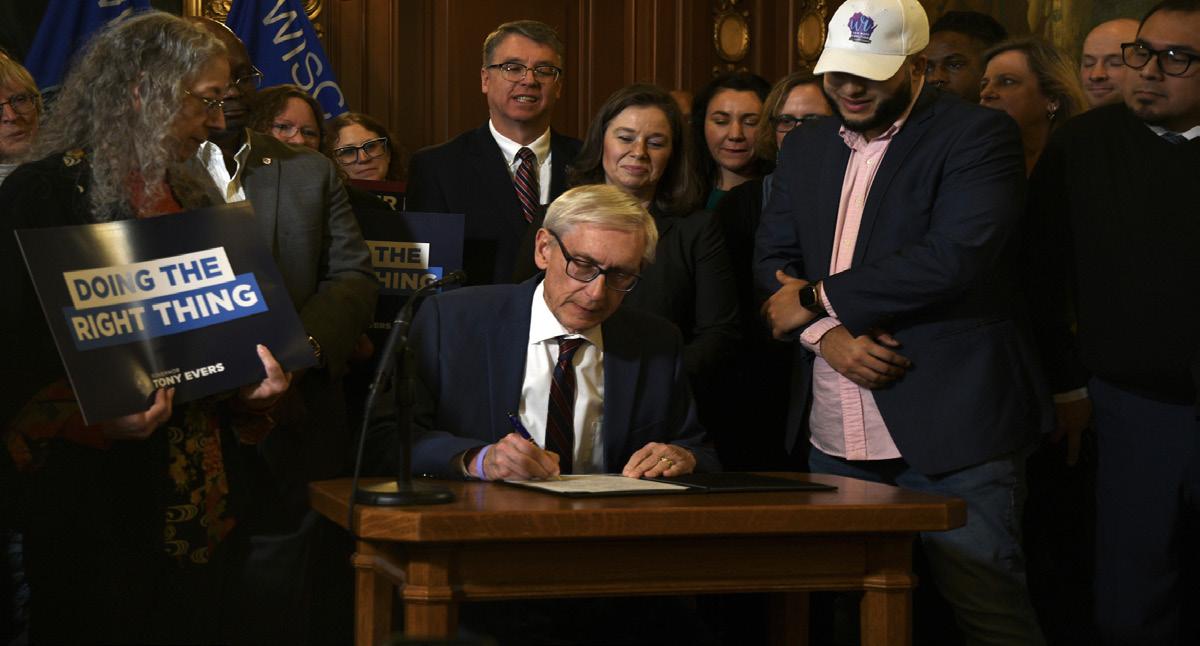
districts will remain in office until their current term ends in 2026.
Heather Williams, President of Democratic Legislative Campaign Committee, said the new maps reaffirm Wisconsin’s status as an important target for the upcoming election.
“The time for fair representation in Wisconsin is long overdue, and we are building winning campaigns and sustainable infrastructure to build power this cycle and ultimately take back both majorities,” he said in a statement.
Evers vetoed a previous map proposal submitted by the Legislature in January because it aimed to keep incumbent legislators in their current districts.
Every 10 years, Wisconsin
redraws its legislative and congressional district maps using data from the decennial census, according to the People’s Map Commission. A nonpartisan ninemember panel from the People’s Map Commission uses the 2020 U.S. Census data and public hearing testimony before submitting a proposal to Evers and the Legislature to approve.
The 2011 legislative maps were drawn and cemented by the Republican-controlled Legislature. Last year, Evers could not reach an agreement for new maps with the Legislature, ultimately leaving the then-conservative leaning court to pass the Republican’s plan based on the 2011 maps.
Meet some of UW-Madison’s 14 students, alumni recognized as Fulbright scholars
By Sophia Simon STAFF WRITER
The United States Bureau of Education and Cultural Affairs recognized 14 University of WisconsinMadison students and alumni as 2024 Fulbright Scholar Program awardees in early February.
The Fulbright Program, coordinated at UW-Madison by Mark Lilleleht, sends scholars abroad in an exchange program while visiting scholars come to the United States. UW-Madison was one of the top 30 universities for scholars receiving grants, according to a Feb. 13 press release, ranking 28th globally for numbers of Fulbright recipients.
The program is funded primarily by the U.S. Congress to foster international connections. Candidates create a research proposal and work on projects with universities in their chosen country.
The Daily Cardinal interviewed three of UW-Madison’s 14 awardees.
Betty Nen
Betty Nen, a 2020 UW-Madison graduate in political science and Southeast Asian studies, will be researching indigenous community resilience during climate-related disasters at Monash University in Malaysia. Nen said she’s interested in discovering how governments prepare for disasters and keep local communities safe.
Nen said she applied for the Fulbright Program after working as an emergency preparedness specialist for the Federal Emergency Management Agency, which sparked an interest in
helping vulnerable communities.
Malaysia was the best fit for her research, Nen said. “It would allow me the most room to grow and the ability to connect with indigenous groups there.”
Her day-to-day research will consist of qualitative research and interviews with different nonprofits and nongovernmental organizations, Nen said. She’ll focus on connecting with indigenous groups in Malaysia and capacity development building within small communities and community-based organizations.
Nen said her studies in political science and Southeast Asian studies at UW-Madison helped her think of current events from different perspectives.
“People are very curious there, and my classes always pushed me to think critically and to expand my views and change preconceived notions,” she added.
Mary Girad
Mary Girad, a 1982 UW-Madison graduate in education and political science, received a study and research grant and will be working through Jawaharlal Nehru University in Delhi, India. Girad’s research focuses on studying tribal folktales of the Adivasi community, an indigenous group in India.
Her interest in South Asian studies stemmed from growing up in India, she said. That interest only grew when she came to UW-Madison.
“I was so excited that there were so many classes about India, a great library, and over the years, a grow-
ing Indian population in Madison,” Girad said.
Starting in 2019, Girad began research for a book about a tribal woman in India, but she said the prospect of traveling to India was financially out of reach. She found out Fulbright extends to alumni and applied in October 2022.
Girad said she hopes to understand her own ancestors’ encounters with the Adivasi and apply the group’s perspective to her research. Girad has a personal connection to the research — her great-great-grandfather came to India from Germany and learned a tribal language called Kurukh.
His work recorded “folktales, songs, riddles and idioms that he had heard,” Girad said. Through her research, she said she wants to understand her own ancestors’ language and connect to her great-great-grandfather’s work.
Aniya Schwoerer
Aniya Schwoerer, an East Asian language and culture graduate who focused on Korean studies during her time at UW-Madison, was awarded the Elementary Education English Teaching Assistant Award. She is currently teaching English to young students in South Korea in Andong-si.
Schwoerer said the goal of the Teaching Assistant Award is to provide more teachers and “shape us as cultural ambassadors with the tools and experiences we need to make an impact on our own communities.”
After she graduated from UW-Madison in 2022, she taught
English as a second language to adults who were refugees or immigrants through the Literacy Network for a year. Schwoerer said she decided to apply for a Fulbright scholarship to better understand her students’ experiences. Even after her Fulbright program ends, Schwoerer said she wants to continue the work, citing an increasing number of people who need to learn English and a need to provide language resources.
Schwoerer said her time at UW-Madison taught her to face challenges, receive cultural exposure and gain confidence in teaching English to others. A large part of that was owed to her professors’ cultural backgrounds, she said.
“[I] had the opportunity to learn about the Koreas from the viewpoints of native Koreans, KoreanAmericans and foreigners,” Schwoerer said. That education allowed her to learn the power of differing perspectives and the presence of her own biases, she added.
In leaving for Andong-si, Schwoerer said she hopes to create the same cultural exposure for others.
“Our idea of cultural differences becomes more complex, how we experience culture becomes more sophisticated and our intercultural relations in cross-cultural situations improve,” Schwoerer said. “As we step away from our own culture being centralized in our reality, we can begin to take into account differences in perspectives and adapt better.”
2 Thursday, February 22, 2024 news ‘A beautiful day in Wisconsin’: Evers signs new election maps into law Corrections or clarifications? Call The Daily Cardinal office at 608-262-8000 or send an email to edit@dailycardinal.com. For the record l An independent student newspaper, serving the University of Wisconsin-Madison community since 1892 Volume 133, Issue 22 2142 Vilas Communication Hall 821 University Avenue Madison, Wis., 53706-1497 (608) 262-8000 News and Editorial edit@dailycardinal.com News Team News Manager Ella Gorodetzky Campus Editor Liam Beran College Editor Noe Goldhaber City Editor Marin Rosen State Editor Ava Menkes Associate News Editor Jasper Bernstein Features Editor Ellie Bourdo Opinion Editors Franchesca Reuter • Lauren Stoneman Arts Editors Gabriella Hartlaub • Anna Kleiber Sports Editors Maddie Sacks • Seth Kruger Special Pages Editor Annika Bereny Photo Editor Mary Bosch • Raaidah Aqeel Graphics Editors Paige Stevenson • Hailey Johnson Science Editor Madelyn Anderson Life & Style Editors Cate Schiller • Erin Mercuri Podcast Director Honor Durham Copy Chiefs Isabella Barajas • Jackson Wyatt Copy Editors Ava Menkes • Francesca Pica • Noe Goldhaber • Jack Ecke • Malia Langer •Alexis-Rose Fincher • Clara Strecker • Meredith Schadrie Social Media Manager Rachel Schultz Business and Advertising business@dailycardinal.com Business Manager Emily Chin Advertising Manager Devika Pal Marketing Director Clara Taylor The Daily Cardinal is a nonprofit organization run by its staff members and elected editors. It receives no funds from the university. Operating revenue is generated from advertising and subscription sales. The Daily Cardinal is published weekdays and distributed at the University of WisconsinMadison and its surrounding community with a circulation of 10,000. Capital Newspapers, Inc. is the Cardinal’s printer. The Daily Cardinal is printed on recycled paper. The Cardinal is a member of the Associated Collegiate Press and the Wisconsin Newspaper Association. All copy, photographs and graphics appearing in The Daily Cardinal are the sole property of the Cardinal and may not be reproduced without written permission of the editor in chief. The Daily Cardinal accepts advertising representing a wide range of views. This acceptance does not imply agreement with the views expressed. The Cardinal reserves the right to reject advertisements judged offensive based on imagery, wording or both. Complaints: News and editorial complaints should be presented to the editor in chief. Business and advertising complaints should be presented to the business manager. Letters Policy: Letters must be word processed and must include contact information. No anonymous letters will be printed. All letters to the editor will be printed at the discretion of The Daily Cardinal. Letters may be sent to opinion@ dailycardinal.com. © 2024, The Daily Cardinal Media Corporation ISSN 0011-5398 Editorial Board Graham Brown • Tyler Katzenberger • Em-J Krigsman • Charlotte Relac • Priyanka Vasavan • Drake White-Bergey • Ethan Wollins • Franchesca Reuter • Lauren Stoneman Board of Directors Scott Girard, President • Ishita Chakraborty • Don Miner • Nancy Sandy • Phil Hands • Nathan Kalmoe • Jack Kelly • Barbara Arnold • Jennifer Sereno • Kelly Lecker Editor-in-Chief Drake White-Bergey Managing Editor Tyler Katzenberger MARY BOSCH/THE DAILY CARDINAL dailycardinal.com
Q&A: Dr. Fernie Rodriguez aims to promote community for UW-Madison students
By Ellie Bourdo FEATURES EDITOR
Dr. Fernie Rodriguez will be concluding their fifth week Friday as UW-Madison assistant vice chancellor for student affairs.
Originally from El Paso, Texas, Rodriguez left their hometown as a first-generation student at the University of Texas at Austin, seeing it as an opportunity to explore their queer identity.
After completing a master’s degree at New York University in higher education and student affairs administration, Rodriguez found themself unexpectedly at Carleton College in Northfield, Minnesota. They spent 13 years in Minnesota, completing their Ph.D. at the University of MinnesotaTwin Cities, focusing on masculinity among first-generation gay Latino men along the border.
At the University of WisconsinMadison, Rodriguez said they aim to provide support for all students, especially those in underrepresented communities.
This conversation has been edited forclarityandbrevity.
As associate vice chancellor for student affairs, what specific programs and services do you lead to support student success, especially those focused on underrepresented student populations?
I’m going to tell you the units that are under my leadership — the specific initiatives I’m going to table because I haven’t been here long enough to say. So first, the Multicultural Student Center is under this identity and inclusion area. That includes the Black Cultural Center. It includes the Indigenous Student Center, it includes the Asian Pacific Islander Center,
it includes the Latinx Center. I also have the privilege of supporting the Gender and Sexuality Campus Center, who are tasked with supporting our LGBTQIA+ student communities here on campus. I also get to work with veteran student services [and] the Office of Inclusion Education. And then the other exciting space that I’m able to support is our Center for Interfaith Dialogue. And of course, the McBurney Disability Resource Center, a huge apparatus that supports all students on campus to ensure that faculty have the resources that they need to make their classrooms accessible to our students. I will also be able to develop and implement in partnership with the community, first-generation student initiatives, programming and support.
How do you plan to integrate understanding of intersectional identities into your role to contribute to holistic student development?
In all of my roles, the ways my experience has shaped how I lead are in a few different ways. I’m a firstgeneration kid from the border, I come from a low-income background. That is one of the core realities I have navigated and to some degree will always navigate because poverty is a legacy.
The other piece I hold in my experience is my identity as a MexicanAmerican. I referenced earlier the ongoing — and now normalized — reality of being one of the only people of color in the academic classroom, one of the only people of color at all of the leadership tables that I have been in, in every institution. And then my developing understanding of it at some point was my gay identity. Now I’m realizing it’s my gender identity. Those three identities come up with
classism, racism and transphobia.
If we are not doing programming that allows students to bring in all of those realities along race [and] class, then I believe we are not giving students the full understanding of how to navigate the world after their time at the institution.
The chronic issue in higher education is that Latiné students, black students, specifically at [the University of Minnesota], were not graduating anywhere near the goals that the region had set for us. So going into that space and saying, “Yes, we’re going to celebrate culture, yes, we’re going to engage in discussions around budgeting, around credit, around preparing for the future. But we’re also going to make an effort to bring our communities together to talk about how we are building relationships with faculty and staff.” To talk about how they are developing their study skills, how they are experiencing those small-group dynamics, where racial microaggressions and other aggressions play out as they are navigating differences in identities among peers.
Could you share your approach to leadership, especially in fostering collaboration between Student Affairs and the Division of Diversity, Equity & Educational Achievement? How do you envision your role as a key liaison?
This was one of the parts of the job that excited me. One of the things I started doing at the University of Minnesota I hope I will be able to do to some degree here is understanding that faculty need to know the experiences of the most marginalized communities as they relate to what is happening in their classroom.
The beauty of Student Affairs is that I have been in it, I’ve expe-
rienced it and I’m in a community with students. As the director of the Multicultural Center, I heard so many experiences of our students, whether it was concerns about the syllabus and the curriculum, where they felt either represented or not.
I felt like there was a huge missed opportunity to sit with faculty and hear their experiences supporting students from marginalized communities. Now when I look at this opportunity in this role, and the experience that I know I can bring and have, it is about coming to the table on the academic side of the house. As a representative of Student Affairs, as someone who has lived it but also has a record of advocacy on behalf of and with students, [I want] to be able to come to the table and to start looping faculty into what the experiences are of these communities here at UW-Madison.
In the context of efforts to review and provide direction for student cultural spaces and programming, what strategies do you plan to employ to enhance and support a diverse and inclusive campus environment?
The only way that I know how to do this work is in [a] community with students. The reason that is critical is because any movement on how or what the cultural spaces will look like, do look like and should look like, has to be informed by a leader. I believe I am key to this conversation that has a close understanding of what is happening and what is needed.
By the end of the spring semester, my goal is to be able to speak confidently to fill-in-the-blank student group. In this case, I am paying close attention to our Jewish, Muslim and Palestinian students on campus. It is critical for me to hear their perspec-
tives and their stories.
I envision a campus culture and climate that supports students in their racial identity but also supports students in their sexual orientation or gender identity or class background. I hope to carve out a campus that has all of our identity and inclusion centers — whether it be the Center for Interfaith Dialogue, the Multicultural Student Center or the Gender and Sexuality Campus Center — coming together to provide initiatives and programs that celebrate someone’s queer identity, but also that name their spiritual journey and their religious affiliation.
As a first-generation college graduate, how do your personal experiences shape your approach to advocating for students, especially those from similar backgrounds?
As a first-generation student at UT Austin, I remember many critiques around the so-called affirmative action that Texas implemented. I am someone who benefited from UT Austin’s top 10% rule. 9/11 had just happened, the war in Iraq and Afghanistan was taking off and the racial tensions on campus were hot.
Somehow, I never lost sight of why I was at UT Austin in the midst of a lot of homophobia, a lot of classism, a lot of racism, a lot of microaggressions and a lot of reasons as to why I wouldn’t finish my degree. Somehow, the universe allowed me to come back to the center and remind myself over and over again why I was there.
I want our students from firstgeneration backgrounds [to] not just to make it but thrive. I want all of our first-generation students to know and to be reminded why they started this journey to begin with: to walk across that graduation stage so they can be the first graduates in their family.
State Street Night Vending program sparks debate about effectiveness
By Vanessa Gavilan STAFF WRITER
The Madison Common Council proposed the State Street Night Vending program at a Feb. 13 meeting, where several members of the council and community spoke about its viability.
The proposal is part of the process to replace the current Late Night Street Vending program. The new program would change the hours of operation from 9 p.m.-4 a.m. to 8 p.m.-12:30 a.m. The proposal would also move all latenight food trucks from State Street to Library Mall on the University of Wisconsin-Madison campus.
The program is part of a fiveyear plan that began in 2018 to replace the current operation hours by April 15, 2024.
Street Vending Coordinator Meghan Blake-Horst told The Daily Cardinal the new program will provide more safety for both vendors and customers during late hours.
“Bringing all the carts together in one area will provide a way for vendors to support and look out for each other,” Blake-Horst said. “It will be in a location that is designed for vending and a safer pedestrian environment.”
The policy will also add vendors to the late-night licensing, which BlakeHorst said will help vendors adapt to changes together.
“This will be a big change for them,” Blake-Horst said. “We have been working to craft a new program that will fit the changing needs and dynamics of the community and downtown while focusing on safety.”
Other council members say that there were not enough credible safety concerns to place strict hours of operation. District 8 Alder MGR Govindarajan told the Cardinal he believes the new proposal will not be effective.
“When you check the police reports on the city, you don’t really see many things,” Govindarajan said. “One specific report they were doing is that there was a car that went and drove onto a food truck…that would not take place at the State Street area because it’s a pedestrian area.”
Maggie Jingga, owner of Jakarta Cafe, spoke at the meeting and said these changes would negatively affect her business at peak night hours.
“If we start 8-12, [we’re] busy only about two hours, and then we have to close down,” Jinnga said. “This is no
good because then we cannot do our operation [in the] hour that we sell the most.”
Jingga expressed concerns about missing both the dinner and latenight customers.
“I’m not interested in this,” Jingga said.
Govindarajan and District 2 Ald. Juliana Bennett said they are looking to revise the program to satisfy the wants and needs of vendors like Jingga and late-night customers.
Their proposal would allow food truck vendors to sell from 8 p.m.-2:30 a.m. to accommodate more customers — mainly students — looking to buy food.
Govindarajan suggested the shorter timeframe, which would prohibit sales after 12:30 a.m., was motivated by unease about dealing with students late at night.
“There’s always been this kind of apprehension [from the city] about students going out and partying and just being students,” Govindarajan said.
When the proposal was first announced in 2018, Dan Kennelly, former manager of the city’s Office of Business Resources, cited late-night
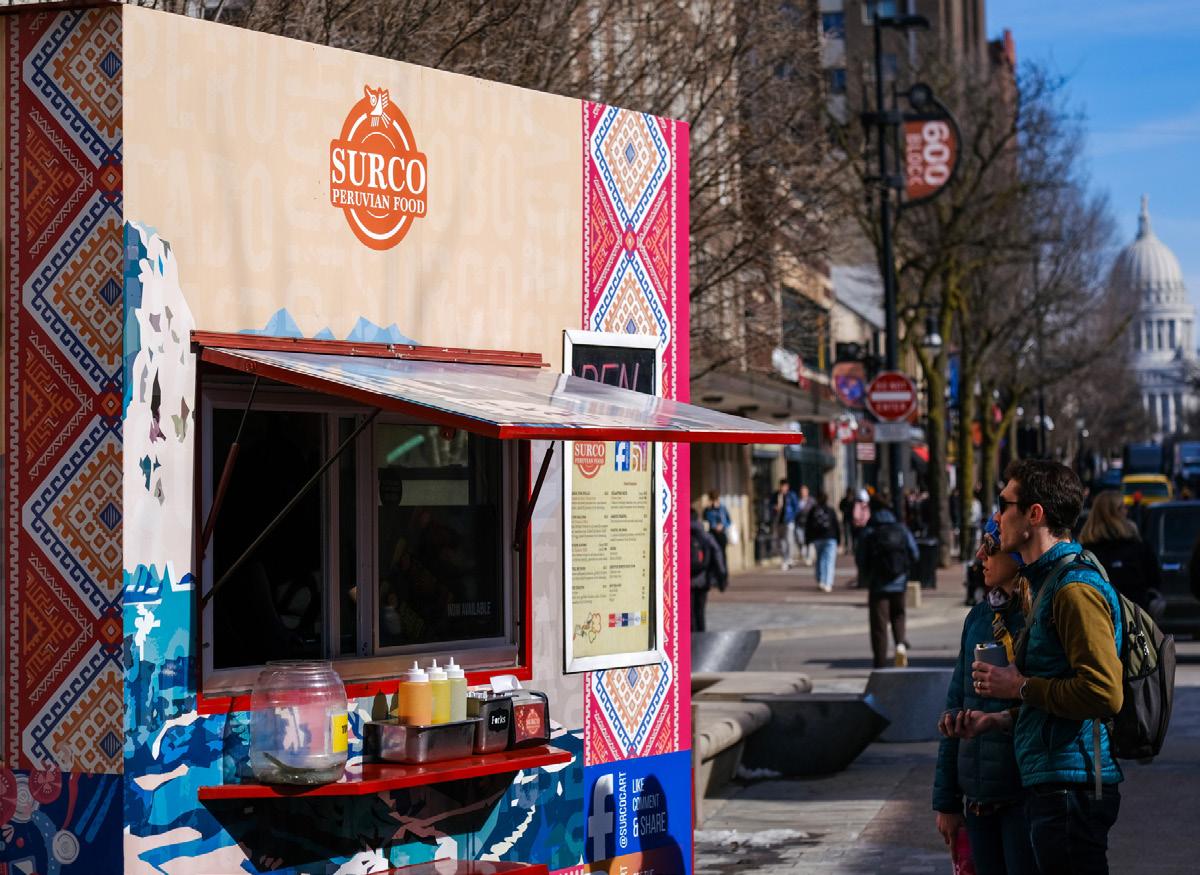
behavior as a main reason for the new program.
“We of course agree that the food carts are not the root cause of this problem,” Kennelly previously told The Cap Times. “They’re serving food, but they do contribute to a reason for people to linger after bar time and that contributes to some of the negative activity.”
Govindarajan pushed back against this notion.
“It’s not just students who are coming back from the bars who might be drunk,” Govindarajan said. “It’s also the students who are up late at night and don’t have a lot of food access. It’s a freshman whose dining halls are closed at that point [that] needs food, cheap food maybe.”
The new program will go to the Vending Oversight Committee on Feb. 28 for referral to the Common Council meeting on March 5.
news
dailycardinal.com Thursday, February 22, 2024 l 3
LIAM BERAN/THE DAILY CARDINAL
UW System launches online degree program
By Bryna Goeking STAFF WRITER
The University of Wisconsin System launched Wisconsin Online, a collaboration between 13 campuses offering over 200 online degrees, on Feb. 1 to increase higher education access for students who need virtual accommodations.
Wisconsin Online revamped previous virtual education efforts and combined all degree programs into one location rather than separating programs by each individual campus as was previously done, UW System officials said in a press release .
“It’s a one-stop-shop that showcases the excellent online education our universities offer, and we anticipate that [Wisconsin Online] will especially appeal to adult learners and traditional-aged students who simply prefer to learn online,” Rothman said.
uate students and transfer students in addition to undergraduate students, according to the press release.
Rothman said he hopes the program will help market the UW System nationally and internationally.
“The Universities of Wisconsin have a great reputation around the nation and the globe, and we want to make our programs as accessible as possible,” Rothman said.
Wisconsin Online also offers non-degree programs, including individual courses, bootcamps and certificates. UW Flex is a competencebased, self-paced program that caters to different adult learning styles, according to the UW Flex website.
Responding to job market changes Wisconsin Online offers 10 associate, 99 bachelor’s and 95 master’s degree programs.
will require higher education.
The move to centralize UW System online education comes during a national student loan crisis. Over 700,000 Wisconsinites carry student loan debt, with the average amount being $32,230 per borrower, according to a 2020 report by the Student Success Through Applied Research lab. Wisconsin now holds more than $23 billion in student loan debt, according to the Badger Institute.
Online degree programs have long been favorable for master’s degree students who are seeking a professional degree while working, according to U.S. News.
Cost of attendance
Tuition for Wisconsin Online varies by degree program and campus affiliation.

As of Feb. 1, 18,000 students were currently enrolled through Wisconsin Online. The program is designed for residents and nonresidents, targeting international students, military students, grad-
Two-thirds of projected jobs in Wisconsin in 2030 with a median salary of $50,000 or more will require a college degree, according to Wisconsin Policy Forum. Although there is evidence of non degree-requiring jobs increasing, higher-paying jobs
Most programs decide costs by charging per credit, typically $200-$300. Some programs charge a flat rate tuition, creating a subscription period for the student to access as much content as they can.
HAILEY JOHNSON/THE DAILY CARDINAL
education in the best time and format, allowing for those who need to work while attending school. In the 2021-2022 academic year, 80% of fully online UW System students were part-time students, according to the website.
loans, military benefits and tuition reimbursement from employers. Tuition reimbursement favors professionals seeking additional education for their career. The online format allows students of all levels to receive 4 Thursday, February 22, 2024 dailycardinal.com news l
Bakke gaming room reflects growing investment in UW-Madison esports
University of WisconsinMadison gamers have found a community among light-up keyboards and high-end monitors in the Bakke Recreation Center’s esports room, which opened at the beginning of the spring semester.
The $100,000 room boasts 12 computers and a variety of setups for gamers of all types. The investment reflects a nationwide higher education trend: many universities are adding esports academic programs and spaces like the one at Bakke to their campuses in response to student interests and job markets.
In Madison, the esports room reflects a growing economic sector furnished by companies and studios like Epic Games and Respawn Entertainment.
By Sophia Ross STAFF WRITER
A Dane County substance abuse recovery program for incarcerated people helped thousands in 2023.
The Medical Assistance Treatment (MAT) program, implemented in 2022 at the Dane County Jail, provided recovery services to 2,637 incarcerated individuals last year, according to a Dane County Sheriff’s Office spokesperson.
Sheriff Kalvin Barrett first announced the MAT program in 2022 and has continued to sing its praises since.
“By nearly doubling the number of people receiving medica-
For some experts, working in esports — a sector projected to bring $4.3 billion in U.S. revenue in 2024, according to Statista — develops relevant skills for any industry.
UW-Stout introduced an esports coaching certificate program in fall 2023. According to a UW System press release, the school’s successful varsity esports team helped originate the program, which will require students to coach one sports team at any level.
“The skills one would need to work in esports are transferable to many other careers. Training in esports is a good investment,” said Dr. Krista Lee Malone, a professor in the game design certificate program at UW-Madison.
The program involves classes from the departments of computer science, theatre and art.
tion treatment in our jail in just over a year, we know the need for opioid treatment in our community is substantial,” Barrett said in a Feb. 5 press release. “It is programs like this that address the root cause of incarceration and help stop the vicious cycle of criminalizing addiction.”
Dane County Sheriff’s Office implemented the program in hopes of ensuring incarcerated individuals did not immediately re-enter prison upon their release, according to a 2022 press release.
“Our ultimate goal is to reduce recidivism. When we reduce recidivism, we reduce the jail population. By reducing the jail
Despite demand beyond its available slots, Malone said the program is small and specific for more individualized instruction.
Alejandro Robinson, president of the Madison Esports Club, said students are interested in various fields within esports: advertising, graphic design, marketing and professional competition.
“We’re trying to find places in the club where they can use those interests and shine,” Robinson said.
Robinson said the Bakke Center’s esports room changed the landscape of his club. After the room’s opening, the club had an easier time building deeper connections with members.
“Having an in-person space where you can practice and hang out together, I can tell just from the team’s dynamics, has
population, we decrease the crime rates,” Barrett said at a 2022 press conference. “By decreasing the crime rates, we increase public safety and we reduce criminal justice budgets.”
Dane County Sheriff’s Office spokesperson Elise Schaffer said in a 2022 press release that inmates were not able receive medication or treatment for addiction once imprisoned in prior years, which interrupted their recovery.
The Dane County Sheriff’s Office turned to substance abuse treatment experts while promoting the MAT program. Dr. Elizabeth Salisbury-Afshar was one such expert and specializes

changed a lot,” Robinson said.
In using the esports room, Robinson hopes the club will be able to recruit more casual gamers to join and increase club support from UW-Madison.
in studying addiction treatment program implementation.
Salisbury-Afshar stressed the dangers of halting substance abuse treatment for incarcerated individuals at the 2022 press conference.
“We know from research that this puts people at risk for multiple things. It reduces the chance that they re-enter treatment when they leave,” Salisbury-Afshar said. “It also increases their risk for resuming use and increases risk of overdose death.”
The MAT program served medicine to 269 residents in its first year, according to a Feb. 5, 2023 press release.
Inmates in the program
MARY BOSCH/THE DAILY CARDINAL
“Our hope is that as the space is used more often, we start collecting these statistics showing [usage] and tell the university, ‘Hey guys, a lot of people are using the space. We need more,’” Robinson said.
received Subutex and Vivitrol, two prescription medications used for treating substance addiction.
The Dane County Sheriff’s Office has significant goals for the Madison area’s future regarding addiction recovery and believe the MAT program will aid with this, according to Schaffer.
“The individuals in our jail are typically there for a very short time, so maintaining their treatment plan during that time is crucial,” Schaffer told The Daily Cardinal.
Schaffer said officials believe the program will reduce recidivism and increase community safety.
Similar to in-person degrees, financial support is awarded through grants, scholarships,
By Gabriella Hartlaub ARTS EDITOR
County program treats inmates recovering from opioid addictions
The Blood Tribe isn’t from Wisconsin. But other fascist groups were
By Jasper Bernstein & Liam Beran ASSOCIATE NEWS EDITOR & CAMPUS NEWS EDITOR
Elizabeth Richter Boxell was holding her daughter when she first noticed the black-clad, swastika-bearing neo-Nazis marching toward a Pride in the Park event in Watertown, Wisconsin last July.
She trembled, turned around and froze, trying to process the situation.
“A group with so much hatred, who is so stereotypically dangerous, was at our small town USA Pride event,” Boxell said.
As the neo-Nazi demonstrators, members of a group known as the Blood Tribe, began to spout epithets and bigotry at eventgoers, Robin Kangas, vice president of the LGBTQ+ advocacy group Unity Project of Watertown, tried to bring community members away from the demonstrators.
“There’s a lot of hatred towards the queer community,” Kangas said.
“It’s just you don’t think that it’ll actually happen to you, you know?”
In more recent months, the Blood Tribe chanted antisemitic and racist epithets during a November march through Madison. At the University of Wisconsin-Whitewater in January, they projected a swastika on a dormitory.
Prominent Madison and Wisconsin leaders like Gov. Tony Evers, Madison Mayor Satya RhodesConway and UW-Madison Chancellor Jennifer Mnookin quickly issued public condemnations of the Blood Tribe after their demonstration in Madison.
When UW-Madison student Ben Newman learned of Blood Tribe’s presence in Madison via social media, he decided to film their activity to prevent misinformation around their message. He felt the neo-Nazis were emboldened by a heightened political and on-campus climate of antisemitic speech amid the war between Israel and Hamas.
“It was a real shock to see people walking down State Street with swastika flags and chanting hateful things,” Newman said.
Despite recent activity in Wisconsin, the Blood Tribe isn’t — or, at least, wasn’t always — a local fixture. Founded by former U.S. Marine Christopher Polhaus in 2020, the group claims to have chapters across the United States. Polhaus previously ran a paramilitary-style training camp in Maine but sold the property after receiving widespread attention from local residents.
The group most recently marched on Feb. 18 in Nashville.
Months earlier in Watertown, Kangas said he knew it was always a possibility that Nazis could appear at a Pride event similar to this. But he didn’t think they would come to his small town.
“I feel like the only reason why they felt it was okay to come here was
because they saw the hatred fundamentalists were spreading in the community,” Kangas said.
How has fascism marked Wisconsin history?
Neo-Nazi propaganda has exploded nationally over a five-year period, multiplying tenfold since 2017. Experts have tied the increase to increasingly public far-right ideology offered by social media and encouraged instances of political violence.
But fascist groups are nothing new in Wisconsin.
As fascism seeped through international waters into the United States and Wisconsin in the 1920s, numerous groups promoted the nascent ideology. Fascism began making inroads into the Dairy State around the 1930s.
Before then, the stage for fascism was set in the nineteenth century by rising cultural uncertainty and the birth of the KKK.
“We talk about culture wars today, but in the 1920s they had some rather similar concerns,” said Dr. Mark Van Ells, a professor of history at Queensborough Community College in New York.
At the time, an increasingly stark divide between cultural interests of rural and urban residents appeared as more people began to live in cities than the countryside, Van Ells said.
“Rural people felt left behind,” Van Ells said. “[It’s] not unlike the red state [versus] blue state thing we see now.”
Cultural instability paved the way for fascism’s spread in the U.S., he added.
Popular culture played a key role in fascism’s spread. In the 1930s, figures like Father Coughlin, a fundamentalist Catholic radio host based near Detroit, began to broadcast profascist, pro-Mussolini and pro-Hitler messaging to a considerable audience. Some experts estimate these shows had up to 30 million listeners.
During this time, chapters of the pro-Nazi German-American Bund — the German word for league or confederacy — spread to different locations throughout America, similar to the Blood Tribe’s chapter-based approach.
The Bund had around 25,000 members nationally, Van Ells said. Its leader, Fritz Kuhn, was known as the leading antisemite in the country. Despite resistance from many local community members, Bund chapters spread pro-Nazi sentiments in big cities and suburbs nationally.
In the small town of Grafton, Wis., the German-American Bund operated Camp Hindenburg, a youth summer camp meant to indoctrinate children into fascist ideology. The camp later closed in 1941 as Bund members faced imprisonment or denaturalization in federal proceedings.
“[Camp members] dressed in uni-
forms, they marched around saying Nazi songs. It was just like the Hitler Youth in Europe,” Van Ells said.
The Bund’s ideological power was widespread, and its Wisconsin chapter had around 5,000 members.
A local connection
Two different UW-Madison student groups donned the Ku Klux Klan moniker — a name separate from the Knights of the Klu Klux Klan — between 1919 and 1926. As an unmasked, above-ground interfraternity society, the UW-Madison Klan was made up of campus royalty, with its members including class presidents, student senators, varsity athletes and theater stars.
That student group infiltrated the Student Union Board, The Daily Cardinal, the YMCA cabinet and a Memorial Union fund drive committee. Although there is “no evidence that this group was ever affiliated with the Knights of the Ku Klux Klan,” the group excluded African American and Jewish students and staff.
“Most of the UW’s ‘student leaders’ were members of the Klan group,” historian Timothy Messer-Kruse said in a 1993 article. “Approval of a group calling itself the Ku Klux Klan as an official campus organization raised not a ripple of concern among the student body.”
Kacie Luccini Butcher, the director of UW-Madison’s Public History Project, told the Cardinal fascist ideology and protests against it appeared frequently throughout the 1920s and 1930s on campus and throughout Madison.
“Students [were] having conversations about World War II in The Daily Cardinal opinion section,” Butcher said. “There is a Wisconsin Alumni Magazine article from [UW-Madison] President Dykstra where he [says] that Hitler and Mussolini and Stalin offer a ‘new slavery.’”
For some, the manufactured appeals of fascism — clean roads, safe streets, a “bold new view” of a supposedly better country — were appealing, Butcher said. But people weren’t seeing what was happening in Germany or other fascist countries due to strict communication controls.
“It’s not like now, where if this was happening, people would be posting on Twitter,” Butcher said. “[Atrocities] were not being communicated to the American public.”
A lack of accurate information was crucial to the rise of fascism, Butcher said. Before phones, restricting media was a more feasible option, and fascist states commonly controlled or assassinated journalists.
In the following years after World War II, students continued to discuss far-right ideologies and fascism, conversations Butcher said are “always happening” on campuses. She cautioned against the narrative
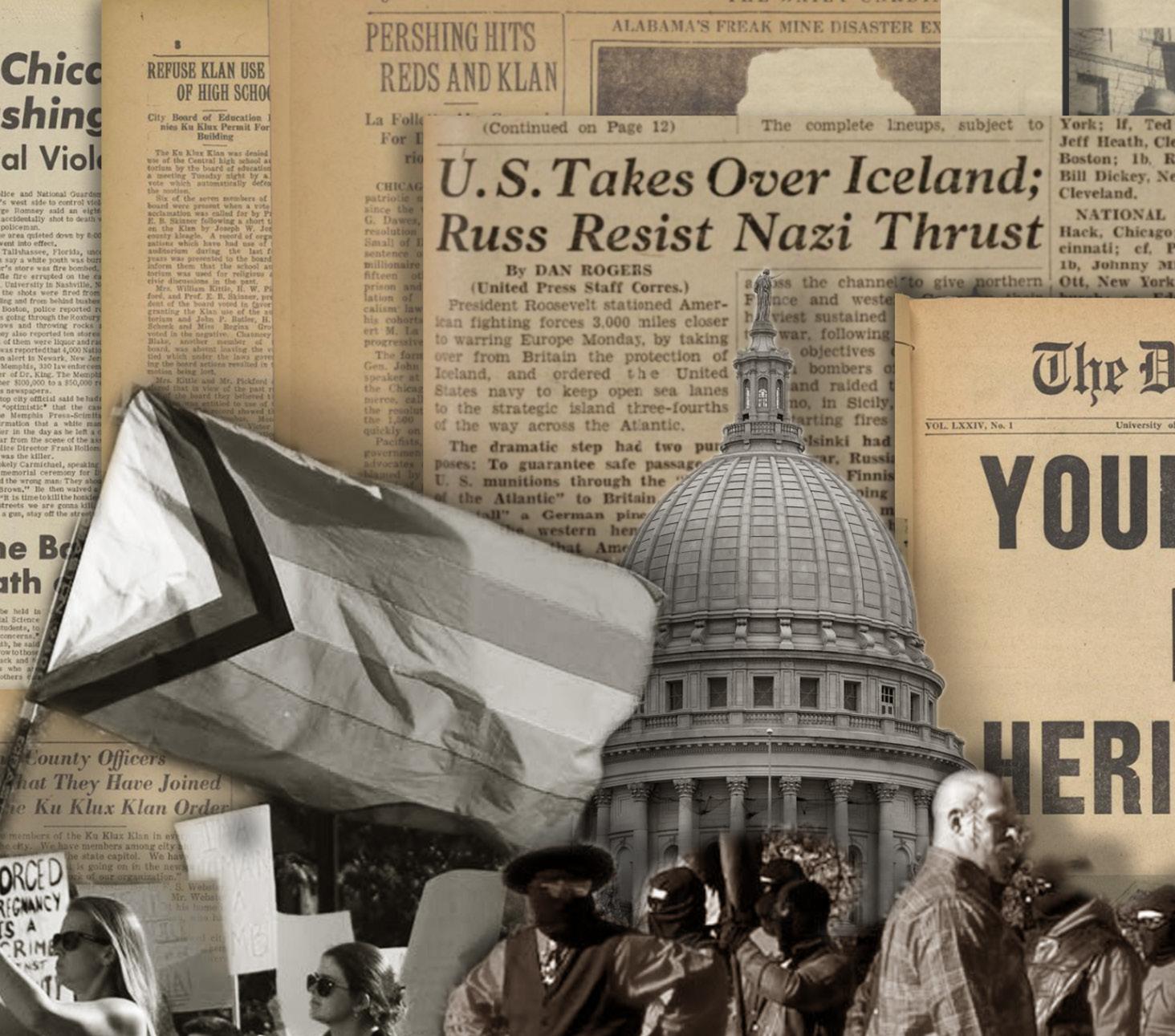
that antisemitism went “out of fashion” after Americans learned about fascism’s horrors.
“That is not true. I think we all know that now, especially in the times we live in. But in 1963, you see a man who feels empowered enough to wear a Nazi armband and disrupt a vigil mourning black children,” Butcher said. “These people are not hiding or cowering. They are making their views known throughout this period and up until today.”
Is anything different now?
Fascism operates under intense ideological and religious zeal, Van Ells and Butcher said. Violence and fear are often beneficial to their cause.
It’s a different worldview than most “normal” people have, Van Ells said. “If you’re a religious fundamentalist, how committed are you to democratic values in the first place?”
That fundamentalist worldview plays into the strict partisan divides which mark American politics today, he said. After the Blood Tribe came, Boxell said some Watertown residents turned their ire toward local police and LGBTQ+ people for bringing the neo-Nazis to town while alleging police “stomped on the Nazis’ First Amendment rights.”
Those beliefs hold true in the current U.S. presidential race, where presumptive Republican nominee and former President Donald Trump openly spews hateful rhetoric about racial minorities and immigrants.
“Illegal immigration is poisoning the blood of our nation,” Trump said in a December post on his social media site Truth Social. “They’re coming from prisons, from mental institutions — from all over the world.”
That statement “echoes the hypernationalistic rhetoric of fascism in the 1930s,” Van Ells said.
The same term — “blood poisoning” — was used by Adolf Hitler in his 1925 manifesto “Mein Kampf.”
Tracking the Blood Tribe’s nationwide activity

And in a December poll conducted by the Des Moines Register, 42% of likely Republican caucusgoers said Trump’s statement about “poisoning the blood” of America makes them more likely to back him. Nearly 30% said that the statement “didn’t matter.”
Far-right ideologies and groups like the Blood Tribe, the Klan and Nazis contain different tactics and end goals. The common threads among the three, however, lie in taking advantage of an uncertain economic and cultural moment to spread hatred.
These ideologies rely on societal decline — the feeling many Germans felt when thinking the Allies had “punished them unfairly,” Van Ells said. And at a time when republican governments face “threats from groups increasingly distrustful of democracy,” Van Ells said the strings echo the same perpetual undercurrent.
“I’m concerned about democracy,” Van Ells said. “That’s the thing that really seems under threat at this point.”
Three months after the Watertown Pride event, Republican legislators passed bills that would ban transgender women from participating in women’s sports and ban genderaffirming medical care for youth in Wisconsin.
“As we warned when these bills received public hearings in the State Assembly, their introduction alone is harmful and dangerous to transgender youth,” said the Wisconsin Legislative LGBTQ+ Caucus in a statement.
“A Republican governor would not want to support a neo-Nazi group,” Boxell said. But she questioned whether a future GOP governor would explicitly condemn the Nazi march or uplift a comparable Pride event in the future.
Additionally, Boxell argued a shifting cultural landscape led to the Blood Tribe feeling a need to demonstrate.
“I think this community and the neo-Nazi community feel like or even the Christian fundamentalists very much feel like they’re losing a grip,” she said. “When neo-Nazis come to your town, you know that you’re doing something right.”
news
dailycardinal.com Thursday, February 22, 2024 l 5
LIAM BERAN/THE DAILY CARDINAL
TIMELINE CREATED BY LIAM BERAN VIA NORTHWESTERN UNIVERSITY KNIGHT LAB

Pro-Palestinian protests continue at career fair
By Amari Mbongwo & Mia Salbego STAFF WRITERS
Pro-Palestinian activist groups hosted a demonstration Monday to protest weapons manufacturers at an engineering career fair and the University of WisconsinMadison Police Department’s alleged violence against a protester on Feb. 13.
Protesters from Mecha De UW-Madison, Madison for Palestine, Students for Justice in Palestine and Anticolonial Scientists spoke out against the inclusion of weapons manufacturing companies with ties to Israel at the engineering career fair last week, including BAE Systems, CAT and General Dynamics.
Chants and signs also criticized UW-Madison administration and campus police for an incident where an officer shoved a protester outside the career fair.
Many of the organizations demanded at the protest and through social media posts that UW-Madison ban on-campus recruitment by weapon manufacturing companies. Protesters also demanded UWPD fire officers involved in the incident and that multiple administrative figures resign, including Chancellor Jennifer Mnookin and Dean of Students Christina Olstad.
Demands have not yet formally been delivered to administration, according to a student protester who asked to remain anonymous.
“They can hear us,” the student said. “We’re going to remain here until they meet our demands.”
Kelly Tyrrell, UW-Madison director of media relations and strategic communications, said administration is aware of the demands.
“The university cannot exclude or otherwise prohibit participation of employers that meet the criteria for career fair participation,” Tyrrell said.
Clara Molina Blanco, a graduate student and teaching assistant, told the Cardinal she believes there is a trend of repression by Mnookin toward student protests.
“We’ve really only been seeing stronger enforcement of protest guidelines after we started protesting for Palestine,” Blanco said.
University Career Services posted protest guidelines outside the career fair, indicating protests could not disturb the event.
A member of UW-Madison’s Protest Support Team contacted a protest organizer to clarify protest guidelines before the Feb. 19 demonstration.
Blanco said she will continue to participate in campus protests despite protest guidelines she said limit protesters’ speech.
“For those of us who were already coming to the protest, this is not going to deter us, if anything, it’s created the opposite effect, which is you’re not going to silence us,” Blanco said.
Also present at the protest was a UW-Madison alum Frank Emspak who recalled his days as a student protesting Dow Chemical during the Vietnam War in 1967.
“During that time there was a deep, moral revulsion about, what is the role of the university? What should we be doing as an educational and intellectual institution?” Emspak said. “Now, with this group, it’s beginning to raise similar issues about the role of the university and its moral compass.”
The university is currently reviewing the Feb. 13 incident.
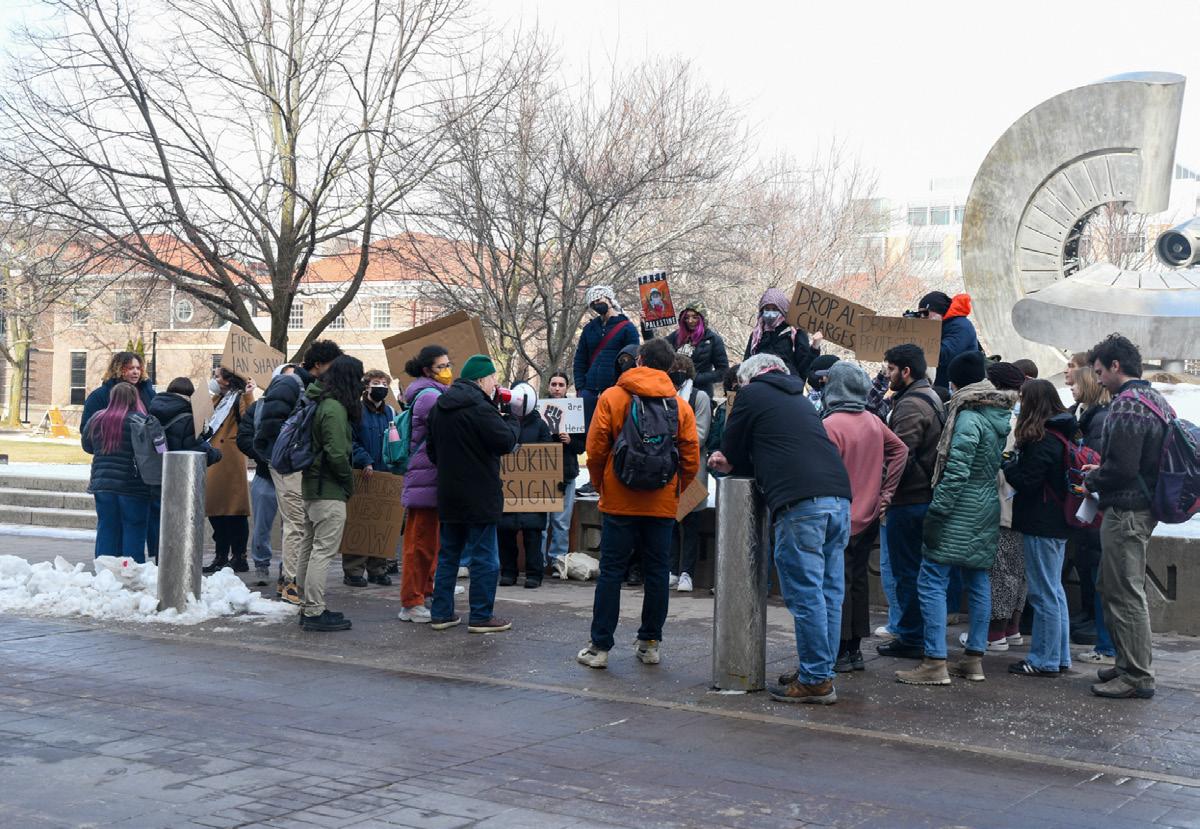
UW receives over $1 million per year from stolen Native land
By Natasha Hicks STAFF WRITER
The University of Wisconsin System receives more than $1 million annually from land first taken from Wisconsin Native American tribes in the 1800s.
The land, some of which is now productive timberland, generated nearly $4 million in total revenue in FY2023 through the Normal School Fund, a pot of money managed by Wisconsin’s Board of Commissioners of Public Lands. The revenue comes from a combination of timber production, land sales and interest on held lands, according to a 2023 BCPL report.
Of that total, $1.25 million was distributed to the UW System, and the rest was reinvested into the fund. UW spent approximately $1.1 million of its distribution.
State trust funds such as these are “one of the best-kept public secrets in America,” according to a sweeping report from Grist, a nonprofit climate media organization. Much of the 68,000 acres of held lands in Wisconsin was taken from the Ojibwe tribe and now makes up the Normal School Trust Fund, which has generated about $30 million in principal.
“The state earns interest and dividends on the land and timber that has been sold, and some of that money is now making its way to the Universities of Wisconsin through the state’s Normal School Fund,” UW-Madison spokesperson John Lucas told The Daily Cardinal.
According to the state Board of Commissioners of Public Lands (BCPL), the fund’s origin traces back to 1850, when the federal Swamp Land Act gave swamps to state governments for conversion into farmland. Wisconsin received title to three million acres of land, regardless of whether the swamp land belonged to Native tribes.
Dr. Margaret Huettl, director of Indigenous Studies at UW-Oshkosh, said many of the swamp lands were protected by Indigenous tribes like the Ojibwe for future generations. When the state harvested timber from lands within reservation boundaries, Native people were not paid, even after legal fights for the land’s protection.
“Today’s generation might not be the perpetrators of a historical wrong, but the Swamp Land Act has ongoing impacts,” Huettl said. “Reckoning with these legacies — really reckoning and making efforts to reconcile, not just acknowledge — is something that we can do together.”
Where do the funds go?
Each year under Wis. Stat 36.49, $100,000 of the funds go to underrepresented students enrolled in certificate or bachelor’s programs at

UW-Madison’s Nelson Institute for Environmental Studies.
UW-Stevens Point receives $300,000 for its environmental programs, and $100,000 goes to students enrolled in the sustainable management degree program through the UW-Extension program, according to state law.
The state Legislature added $5,000 merit-based scholarships under a 2017 statute. The scholarships, which are based on standardized college entrance scores and GPA calculations, are drawn from the remaining balance and distributed to students from Wisconsin high schools or homeschooled students. According to a 2023 BCPL report, the fund led to 150 merit scholarships in 2022.
Originally slated to end on April 1, 2023, the statute was amended last year to run indefinitely.
Some critics have questioned the value of standardized testing for state students. Wisconsin holds significant racial disparities in standardized testing scores and the widest opportunity gap between white and Black students of any state, according to Spectrum News.
Sweeping nationwide impact
The Swamp Land Act isn’t the first act that took away land from Native tribes that now benefit the Universities of Wisconsin. The Morrill Act of 1862 used federally owned land often seized from Indigenous tribes to establish land-grant universities across the U.S., such as UW-Madison.
The seizure spans across universities nationwide. According to the Grist report, 14 land grant universities receive revenue from state trust lands and the Morrill Act, including the University of Minnesota.
For example, the University of Minnesota generates mineral revenues from land obtained from Indigenous tribes, adding up to $17.2 million in profits between 2018 and 2022, according to an analysis from the MinnPost.
Investigators at Grist discovered governments took 8.2 million acres of land from
Indigenous tribes, generating over $2 billion for the recipient schools.
How UW-Madison is responding
While UW-Madison benefits from the Normal School fund and the Morrill Act, Lucas said UW-Madison’s mission is to “make amends for the ways the institution has benefitted from the dispossession of American Indian lands by the federal government.”
Payments from the Normal School Fund to the UW System started in 2009, according to Lucas, and these funds either go towards scholarships for low-income students or are distributed to UW System campuses.
Lucas said UW-Madison values moving from “ignorance to awareness” about the role of land grants and dispossession in UW-Madison’s history and is doing so through the “Our Shared Future” initiative, The First Nationals Cultural Landscape Tour and Indigenous curriculum about the history of Indigenous land expropriation.
In December, UW-Madison established a program covering the cost of attendance of an undergraduate degree and full tuition for law or medical degrees for members of federally-recognized Wisconsin Indian tribes.
While Huettl said there has recently been awareness toward understanding how land grants impact Indigenous faculty and students at schools like UW-Madison, she added that Indigenous staff and students are still underrepresented and undersupported at campuses benefitting from the Normal School funds.
That disparity is also represented in employment, she said.
“Due to cuts and challenges at the state level, there are few if any positions dedicated to our Indigenous students’ success, especially on the former normal school campuses.”
Less than 0.5% of UW System students are Indigenous, and most students leave college without ever learning about Indigenous history, according to Huettl.
6 Thursday, February 22, 2024 dailycardinal.com l news
LIAM BERAN/THE DAILY CARDINAL
BOSCH/THE DAILY CARDINAL
LIAM BERAN/THE DAILY CARDINAL MARY
Black political representation is at its highest, but major gaps persist
By Gabriella Hartlaub ARTS EDITOR
A resolution to recognize February as Black History Month and honor Black changemakers across Wisconsin was introduced this month by Democratic senators after facing rejection in previous years.
The lack of Black representation in the Wisconsin Capitol has left lawmakers struggling to amplify their voices and pass resolutions like those honoring Black History Month.
The first Black representative elected to serve in the state Legislature was Lucian H. Palmer in November 1907. But some of Palmer’s white
neighbors attempted to convince his landlord to evict him from his home in hopes he would be unable to represent the wealthiest district in the state.
Palmer’s district included areas such as Milwaukee’s Third Ward and the majorityBlack Bronzeville neighborhood where Palmer lived. And while Palmer survived the attempt to force him out, he lost his election the next year.
After Palmer lost reelection, there wasn’t another Black person in the Legislature for 33 years.
Black political representation is still left standing
As of February 2024, there are nine Black legislators in Wisconsin. While this is the second-highest of any year, many Black communities still feel left out from state political representation.
All current Black legislators represent districts that encompass all or some of Milwaukee and Dane Counties, home to the largest Black populations in the state.
Eight out of the nine are Democrats except for Julian Bradley, whose district is part of Milwaukee, Waukesha, Racine and Walworth Counties. For Black women, the wait to receive a state political voice would not be until 1977, when

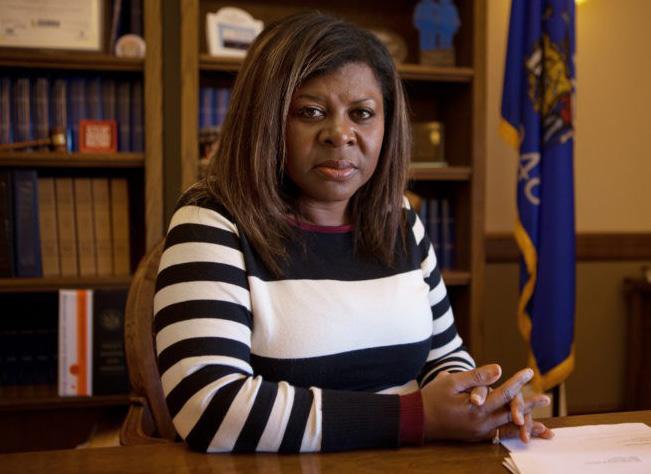
Maria Coggs was elected to the Legislature.
Several Black women, including Rep. LaKeisha Myers, D-Milwaukee, currently serve in the Assembly. Only one serves in the Senate: Sen. LaTonya Johnson, D-Milwaukee.
“In the Senate, it has been more challenging,” Johnson said when asked about her experience as a Black legislator. “I don’t think people are purposely biased, but they have tendencies.”
The importance of the Black voice for voters
Political representation for Black communities allows more focus on the issues that affect them such as poverty, health care, housing and voting, Johnson told The Daily Cardinal.
Johnson said her district grapples with gun violence, particularly against children. After the funeral of one such child, Johnson said she went to one of her colleagues and asked for their help in creating preventative measures against future violence.
“They said, ‘my heart is with you, but that is not happening in my district,’” Johnson said.
Cities such as Beloit and Racine have high Black populations, yet there has not been Black legislators from those areas at all in the state’s history.
Johnson said candidates of color are often overlooked or picked last during elections and are expected to have a certain “look” compared to their white counterparts. Johnson recalled a time she spoke to a recruiter for candidates.
“We were talking about this one particular candidate that was African-American, and she said, ‘well she doesn’t show well,’” Johnson said.
A 2022 analysis done by FiveThirtyEight found only 28% of general election candidates that year were people of color.
“If you’re a minority, you’re all there is,” Johnson said.
Changing the narrative
Black political representation can also change the perspective of other legislators serving more urban areas, Meyers said.
“I invite people to come to the district to experience Milwaukee and understand some of the issues and concerns that residents have,” she said.
The Legislative Black Caucus, headed by Rep. Dora Drake, D-Milwaukee, has advocated for issues they view as important to the Black community.
In wake of the University of Wisconsin System’s deal with the Republicancontrolled Legislature to
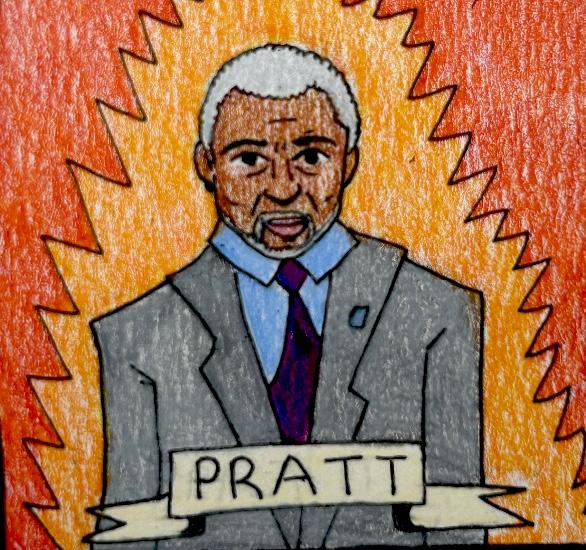
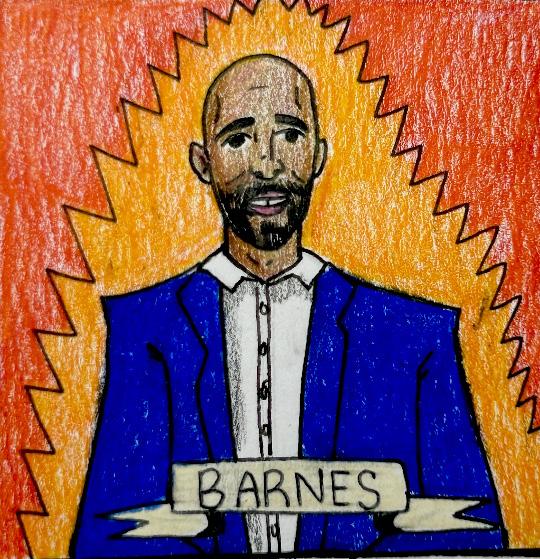


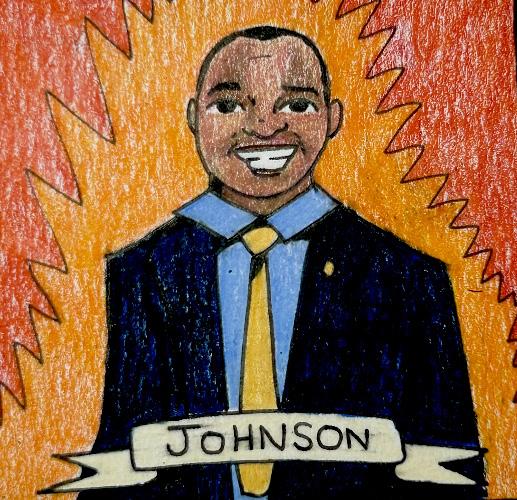
restructure diversity, equity and inclusion (DEI) positions in exchange for pay raises and building projects, the caucus pushed to keep DEI funding in higher education.
They also work to circulate a Black History Month resolution each year, despite backlash in 2020 over choosing which Black changemakers to honor.
Work to increase presentation in the Legislature continues in communities across the state, including Milwaukee, where a primary will take place April 2 to decide the candidate for Sen. Lena Taylor’s empty senate seat. Both candidates, Drake and Myers, are Black.
See more online at dailycardinal.com
news l
GABRIELLA HARTLAUB/THE DAILY CARDINAL
dailycardinal.com Thursday, February 22, 2024 7
TÉALIN ROBINSON /THE DAILY CARDINAL
Marvin Pratt, Mandela Barnes, Vel Phillips, Marcia Coggs and Cavalier Johnson are a few of the Black history makers in Wisconsin.
HAILEY JOHNSON/THE DAILY CARDINAL
The Congressional Black Caucus, including chair Rep. Dora Drake, D-Milwaukee (center), hold a press conference in December 2023.
Sen. LaTonya Johnson, D-Milwaukee, is photographed in her office at the Wisconsin State Capitol.
‘Les Misérables’ remains a revolutionary, timeless classic
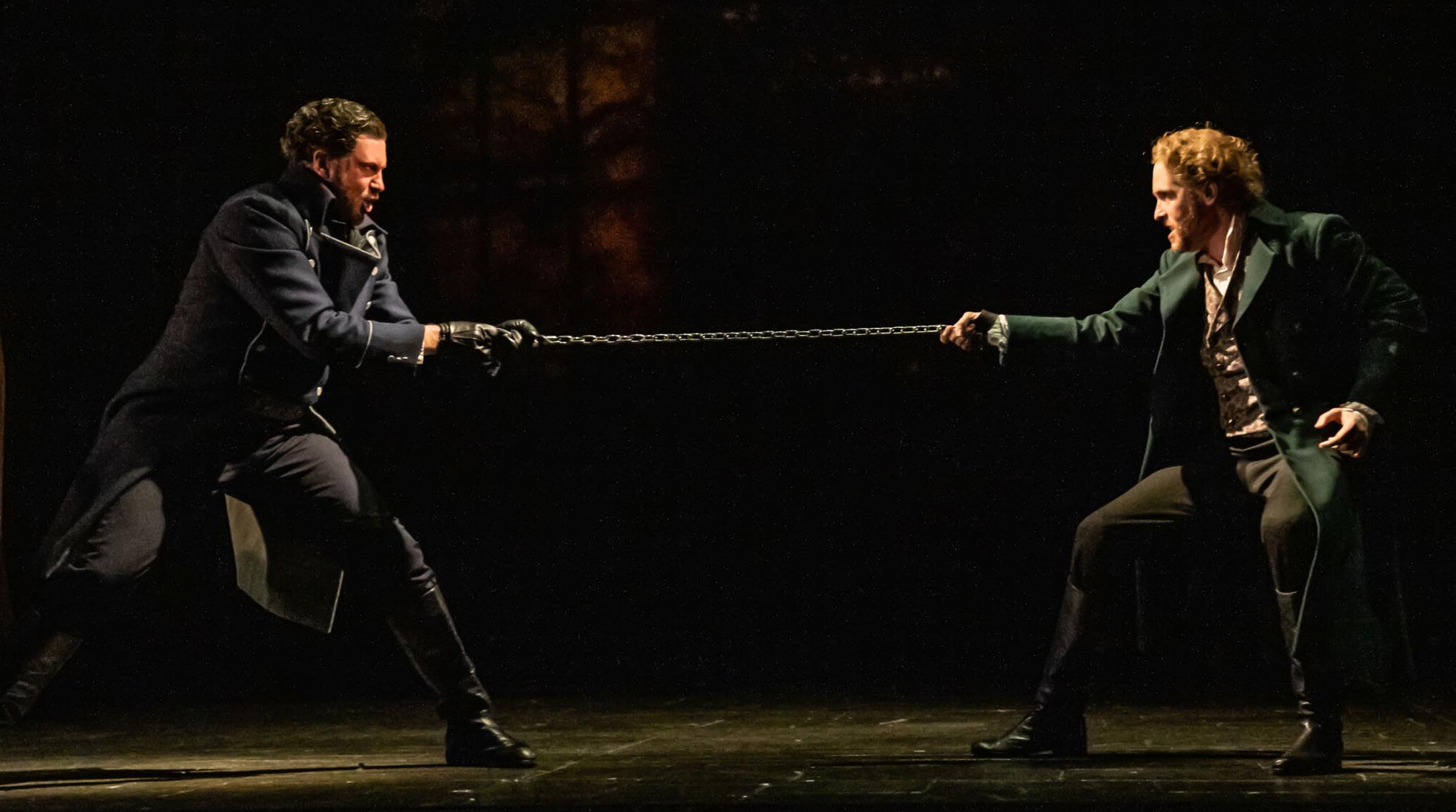 By Anna Kleiber ARTS EDITOR
By Anna Kleiber ARTS EDITOR
Content warning: This story contains information about suicide. This review contains spoilers for “Les Misérables.”
The “Les Misérables” North American Tour took the Overture Center by storm Wednesday night at its opening show for a Feb. 14-18 stop in Madison.
“Les Misérables” is a sungthrough musical with music by Claude-Michel Schönberg and lyrics by Alain Boublil. With well-known classics like “I Dreamed a Dream,” “Bring Him Home” and “One Day More,” “Les Misérables” is a must-see show for theater lovers.
Based on Victor Hugo’s 1862 novel of the same name, “Les Misérables” tells the story of exconvict Jean Valjean and his desire for redemption in 19th-century France. Throughout most of the musical, Valjean is pursued by a
‘The
Flying
By Mak Strohmeyer STAFF WRITER
“The Flying Lovers of Vitebsk” brought a brilliant show of color, music, dance and poetry to the Overture Center at its regional premiere from Jan. 25 to Feb. 11.
The Forward Theater Company, a local professional theater company based in Madison, put on the musical during its opening run in Madison. The musical was written by Daniel Jamieson, an actor and London native.
Set in the backdrop of the early 20th century, “The Flying Lovers of Vitebsk” tells the captivating love story between Marc Chagall — a famous Russian Jewish painter best known for his early modernism — and his wife, Bella.
Chagall’s artworks were transformed from canvas to theatrical stage by Forward. The design team took his paintings and layered them throughout the 90-minute play in the form of lighting, set design and emotionally rich music, creat-
police inspector named Javert who refuses to let him escape justice.
“Les Misérables” opens with a 14-minute prologue that sets the stage for the rest of the nearly threehour-long show. “Les Misérables” isn’t a show you want to arrive late to — if you’re not in your seats for the opening curtain, expect to be held at the doors by ushers until the start of act one.
The show begins in 1815 France as Valjean is finally granted parole after being condemned to 19 years of hard labor for stealing a loaf of bread to feed his family. Valjean is forced to be an outcast, untrusted by others due to his yellow parole papers. Only the Bishop of Digne welcomes Valjean into his home without a second thought, a kind action Valjean repays him for by stealing his precious silver in the night. Despite betraying the Bishop’s trust, he forgives Valjean. The only thing the Bishop asks in return is for Valjean to use the silver to live as an honest man.
Vowing not to take this sec-
ond chance for granted, Valjean proclaims, “I’ll escape now from that world/from the world of Jean Valjean/Jean Valjean is nothing now/another story must begin” as he tears his parole papers, symbolizing the start of his new life.
Nick Cartell stars in the role of Valjean. With an impressive vocal range, Cartell makes Valjean’s powerful belts and soft falsettos sound like a walk in the park, which any musical theater enthusiast knows is no easy feat.
Having seen this same tour in December 2022 in Milwaukee, it’s always thrilling to see what different performers will bring to these well-known roles. While Cartell remained impressive in both performances and was my personal favorite portrayal of Valjean to date, Preston Truman Boyd’s performance as Javert was unlike any other, standing out from prior actors I have seen in the same role.
Javet is arguably the most complex character in the musical as
he uniquely contrasts Valjean, their dynamic being the perfect example of foil characters. Valjean believes people can change and do so for the better. He is merciful and good despite past sins. Javert, however, believes in justice above all. To him, there is only right and wrong, black and white.
Boyd took a fascinating approach to portraying Javert which I have not yet seen on this tour. Javert’s “Soliloquy” in act two can make or break an actor’s performance in this role, and Boyd didn’t disappoint.
Javert spends the entire play chasing Valjean, convinced that people can’t change for the better. At every intersection of the two, Valjean proves Javert’s preconceived notions wrong. After breaking his parole, Valjean adopts an orphaned child, saves Marius from the barricade and even spares Javert’s life when given the opportunity to kill him.
In Boyd’s performance of Javert’s “Soliloquy,” the audience sees a frantic Javert unraveling before them as he realizes everything he believed was wrong. Boyd’s performance highlighted Javert’s internal conflict in a raw, gut-wrenching fashion that shook me to my core.
Boyd portrayed Javert’s final moments before his suicide with an almost manic sense of urgency as he questions everything he has ever known. Echoing Valjean’s “Soliloquy,” Javert’s final words start with, “I’ll escape now from that world/from the world of Jean Valjean.” Unlike in Valjean’s “Soliloquy,” Javert chooses to take his own life instead of beginning another story. With the same motif that begins Valjean’s new life, Javert ends his, his final words being “there is nowhere I can turn/there is no way to go on.”
The staging and set design for “Les Misérables” were as impressive as the performances. With an intricate set made of moving pieces, purposeful lighting and innovative use of a visual screen to further supplement the physical set, it’s hard not to feel like you have teleported into 19th-century France.
Set pieces and actors both moved with purpose. The barricade scenes in particular are quite spectacular as the audience sees the revolutionary students fight for a better France from behind the barricade. You cannot see the French soldiers they are fighting, only flashes of light accompanied by gunshots and smoke.
As far as creativity goes, “Empty Chairs at Empty Tables” has one of the most moving stagings. After all the students but Marius perish at the barricade, Marius sings a somber ballad on the stage alone surrounded by lit candles in the place where his friends used to meet. At the climax of the song, the ghosts of his friends raise the candles like glasses before blowing them out, mirroring scenes earlier in the play where they would meet and drink together as they planned their now failed revolution. It is evident that a lot of love and consideration went into the production and staging of this tour as scenes like “Empty Chairs at Empty Tables” never fail to evoke emotion.
“Les Misérables” is a brilliant show, though it is not for the faint of heart. While I knew what I was walking into, I couldn’t help but chuckle when one theater-goer said he felt like the show could’ve been a half-hour shorter during the standing ovation. I mean, what could be more fitting than a three-hour musical to tell a 1462page story? After all, Hugo’s novel isn’t nicknamed “the brick” for just any reason.
Lovers of Vitebsk’ is a spectacle of art and love
ing an imaginative spectacle combining multiple mediums of artistic storytelling.
Chagall’s art showed up in the stained glass backdrop of the stage, costuming for Chagall and Bella, and Chagall’s actual portraits. One character, a Rabbi, was even played by a physical Chagall painting.
What did art mean in an inaccessible age? Like most theatrical shows, “The Flying Lovers of Vitebsk” informally asked big questions through poetry, movement and song. Chagall witnessed wars, revolutions, births and deaths. Different social and environmental circumstances influence the inward reflections upon viewing art in the theater. This was just one of the musical’s many messages, art is based on interpretation. It is based on human experience.
For Chagall and Bella, art was not as accessible as it is today. You could not create something on a computer or find inspiration from apps like Instagram or Pinterest. Art was much harder
to create, and artists who could make a living from their work were few and far between.
What held the two together in their pursuits was mutual love.
“Each night Marc comes home, and we invent a new color,” Bella (Emily Glick) said during the show.
The couple emphasized that to create art, you also need to create love, a concept the show depicted as an inseparable duality with pain. To continue as an artist, you must believe in what you are creating, who you are creating for and why you are creating.
“The Flying Lovers of Vitebsk” immerses audience members into a world of pure imagination. In the show, Chagall (Marcus Truschinski) took much of his artistic inspiration from his childhood. When he grew older and had to report to the financial and social constraints of being an adult, he came to an artistic block.
The lighting team showed the ebbs and flows of Chagall’s creativity. Lively bright hues
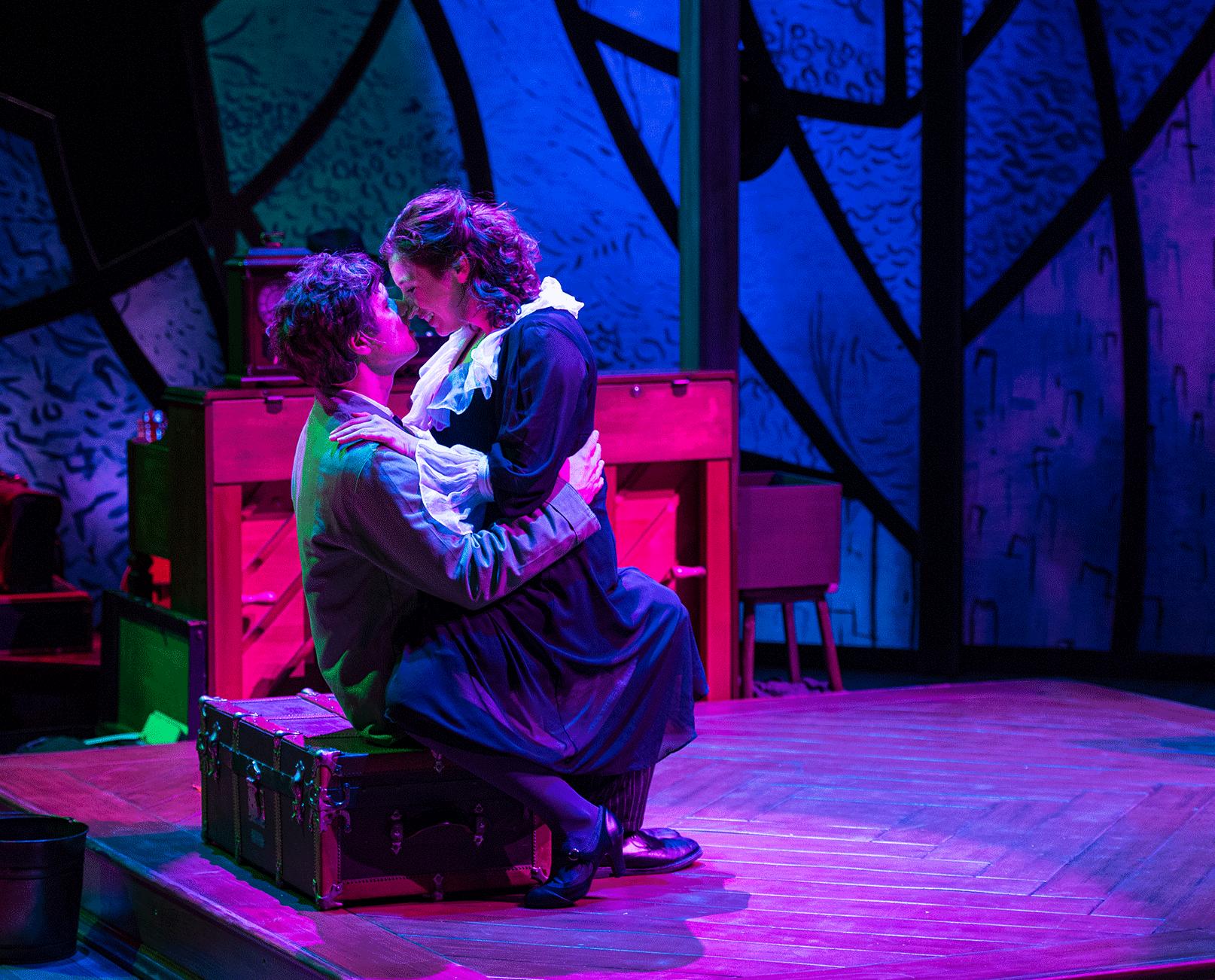
of green and purple appeared when Marc was inspired, and darker, bleaker colors appeared when he was frustrated.
The audience is put directly into Chagall’s mind, seeing and feeling what Chagall sees and feels, just through different eyes. The perspective furthers a central theme
addressed in the show: when someone is your soulmate, you see things the same through different eyes.
“The Flying Lovers of Vitebsk” shows how love can be art. It is a painfully beautiful and inspiring show that encompasses the immeasurable existence of an artist.
8 Thursday, February 22, 2024 dailycardinal.com arts
COURTESY OF MATTHEW MURPHY & EVAN ZIMMERMAN/MURPHYMADE
PHOTO COURTESY OF ROSS ZENTNER
Ice core: Will the heart of Madison winter’s keep melting?
Warming temperatures impact ice events. They harm the lake’s ecosystem, too.
By Britta Wellenstein STAFF WRITER
Madison winters are often centered around the ice on Lakes Mendota and Monona. From hockey games to ice skating to Lady Liberty and festivals, Madisonians form a community around the cold days and thick ice.
This year, though, Lady Liberty sat on Library Mall, the Clean Lakes Alliance Frozen Assets Festival canceled their ice events and university police urged the public to stay off the ice due to unsafe conditions.
However, these conditions aren’t a surprise. Data shows this ecosystem has been changing.
For 170 years, the Wisconsin Climatology Office has kept records of ice cover on Lake Mendota and neighboring lakes. These records show Lake Mendota sees fewer days of ice cover than before, with later freeze dates and earlier thaw dates.
Constituting if a lake is “frozen” varies between each body of water. A “frozen” Lake Mendota means there is too much ice to travel from Picnic Point to Maple Bluff by boat.
Lake Mendota officially froze on Jan. 15, the third latest date on record, almost a month after the typical freeze around Dec. 20.
“We’re seeing it statewide. We’re seeing it continent-wide, across the globe: Lake ice durations are becoming shorter and more variable,” said Tyler Butts, a postdoctoral researcher at the UW-Madison Center for Limnology. “This is driven by a changing climate.”
December 2023 was one of the warmest on record for Wisconsin, according to the
Wisconsin State Climatology Office. Overall, the state’s winters are becoming milder, with warmer temperatures, less snowfall and more rainfall.
These factors, along with fluctuating temperatures, play a role in ice formation and ice safety, Butts said.
“With all these swings, where it is above freezing during the day and below freezing at night, [the ice] is a lot less reliable and could impact a lot of the good winter sports that are important for culture and society here in Madison, as well as across the state,” he said. James Tye, founder and executive director of the Clean Lakes Alliance, said Madison’s lakes hold both ecological and cultural significance for the community.
“Our lakes are truly our number one asset for our community. It is the thing that makes Madison special. Wisconsin’s a land grant university, and it was specifically chosen to be on Lake Mendota, ” Tye said. Decreasing ice cover impacts ecosystem wellbeing, particularly the lake’s phenology, Butts said. “There’s this term that a lot of people use to describe the timing of events over the course of the season called phenology,” Butts said. “The animals have been around for a long, long time, and they sort of developed these rhythms.”
When snow on the lake melts, more solar radiation hits the lake, melting the ice and warming the water. This triggers a bloom of zooplankton, a small animal that eats the phytoplankton, Butts explained. In a typical season, by the time zooplankton bloom, fish larvae are hatching and eating

Why is Madison’s weather so weird? A look into the El Niño
the zooplankton, maintaining an ecosystem balance.
When phytoplankton bloom early, zooplankton miss that food source at its peak, creating less zooplankton available for fish when they hatch. Butts said this disrupts the fish population and decreases algae control in the spring.
“It sort of throws off all these things in the lake when we see these really early ice-off dates,” he added.
In addition to food chain disruption, warmer waters affect which fish are favored, Butts said, with decreased habitat for cold water fish like walleye and an increased warm habitat for fish like largemouth bass and invasive species.
Warming ice and melting snow pose another problem for Madison’s lakes: increased flash runoff. Runoff pollution, like phosphorus and chloride, occurs whenever snow melts. But how much runs into waterways depends on the soil — if the soil is frozen when snow melts or it rains, the water cannot be absorbed by the ground, and more flows to the lakes.
This pollution impacts the lake’s ecosystems, especially in the summer. Chloride from road salt can be toxic to aquatic life, according to Wisconsin SaltWise. Phosphorus from fertilizer and cow manure causes more harmful algae blooms like cyanobacteria, according to the Clean Lakes Alliance.
“Everything you put in land eventually washes into lakes,” Tye said. “If you get a lot of rain or a flash melt in the winter, the ground is still frozen, so more of it is going to flush into the lake.”
Tye emphasizes that Wisconsin has taken great strides to reduce the amount of phosphorus pollution and runoff, like adding buffer strips and retention ponds or reducing manure spread in the winter. With more water running into the lake, though, more pollution runs in as well, creating more algae blooms and disrupting water quality later in the summer.
The full effects of a changing climate and changing winter ecosystems are still being discovered. The UW-Madison Center for Limnology is working to expand its research to understand more about changes to wintertime lakes. Looking forward, Butts is unsure what the future holds.
“It’s hard to say. It really depends on a lot of factors that are difficult to predict,” Butts said. “But I can say if we continue on this trend, we’ll just see a continuous decrease in that freeze-thaw cycle… It’s difficult to say what the future might hold.”
 By Lindsay Pfeiffer STAFF WRITER
By Lindsay Pfeiffer STAFF WRITER
Winter has felt more like spring this February, with rising temperatures, a lack of snow and a thunderstorm on campus. Whether you like the warm days or miss winter activities, it’s clear something is causing different weather this year.
This “something” is an El Niño.
What exactly is an El Niño? An El Niño forms when ocean surface temperatures are warmer than usual in the eastern Pacific Ocean. Typically, this means the polar jet stream is further north than its usual place in the south, resulting in abnormally warmer temperatures in the Midwest region of the United States.
This phenomenon was originally recorded by fishermen off the coast of South America. It was named El Niño — “the boy child” in Spanish — because it tends to occur around Christmas.
This isn’t the first year this event has impacted our weather. El Niños usually occur every two to seven years, with the last one in the Midwest occurring eight years ago. It was a powerful El Niño that started in 2014 and lasted through spring of 2016.
This year, temperature records have been broken. On Feb. 8, it was 56 in Milwaukee — a city record. In Madison, the University of Wisconsin Police Department posted via Twitter to stay off Lake Mendota due to thin ice. Additionally, Lake Mendota didn’t fully freeze until Jan. 15, its latest freeze date since 2007.
El Niño also affects local wildlife. Many animals rely on snow to hibernate
or camouflage themselves. Without snow this year, they may be especially vulnerable to predators.
What will this mean for spring? Although many factors will influence what spring will look like, it’s predicted that El Niño will continue to keep temperatures unusually warm in the Midwest and cooler in the southern parts of the United States.
The Midwest is also predicted to experience an overall drier spring, especially in May. Because the Midwest will be entering spring with drier-than-normal soil, the El Niño will likely hinder recovery from drought.
The El Niño may also impact how many insects are around this summer and when they come out. Warm winter might cause ticks to become active sooner in the year. However, there likely won’t be an increase in the number of ticks or the frequency of Lyme disease because a tick has a long life cycle, requiring two years to become an adult.
Despite these climate concerns, the El Niño may have some benefits. A mild winter can be beneficial for livestock producers because it often reduces animal stress and expenses. Additionally, it can be beneficial to homeowners due to the reduced heating cost that comes with a warmer winter.
Although there are many mixed feelings about our unusual winter, it’s important to understand the science behind it. Whether you’re disappointed at the cancellation of your favorite winter festivity or just happy the sun is out, now you know why it’s so warm and what to expect for spring.
science dailycardinal.com Thursday, February 22, 2024 l 9 HAILEY JOHNSON/THE DAILY CARDINAL
HAILEY JOHNSON/THE DAILY CARDINAL














10 Thursday, February 22, 2024 dailycardinal.com special pages l 2024 Bar Guide Awards And Best We ek ni gh t Special: M T W R F The Daily Cardinal is UW-Madison’s oldest student newspaper, and we’ve been on campus since 1892. Back in ye olden days (the mid-2000s), our paper used to run a local business awards contest. Our top editors were out for drinks on a cold December night when we saw an old award in a local bar, and we decided it would be cool to bring awards back. So we did! Our Daily Cardinal staffers submitted nominations, and our editors selected the top few in each category. The categories are: Best College Bar, Best Cocktail Bar, Best Bar Food, Best Environment/Vibe and Best Weeknight Special. These awards have been voted on in the past week by students at UW-Madison, and, without further ado, here are your 2024 winners! Best C cktail Bar: Best F D: Best Atmosphere: DRAKE WHITE-BERGEY/THE DAILY CARDINAL ANNA KLEIBER/THE DAILY CARDINAL ANNIKA BERENY/THE DAILY CARDINAL ANNIKA BERENY/THE DAILY CARDINAL GRAPHIC BY HENRY MOORE GRAPHIC BY HAILEY JOHNSON GRAPHIC BY HAILEY JOHNSON GRAPHIC BY HAILEY JOHNSON Best College Bar: Congratulations to the winners!
Column: More playing time could fix Connor Essegian’s sophomore slump
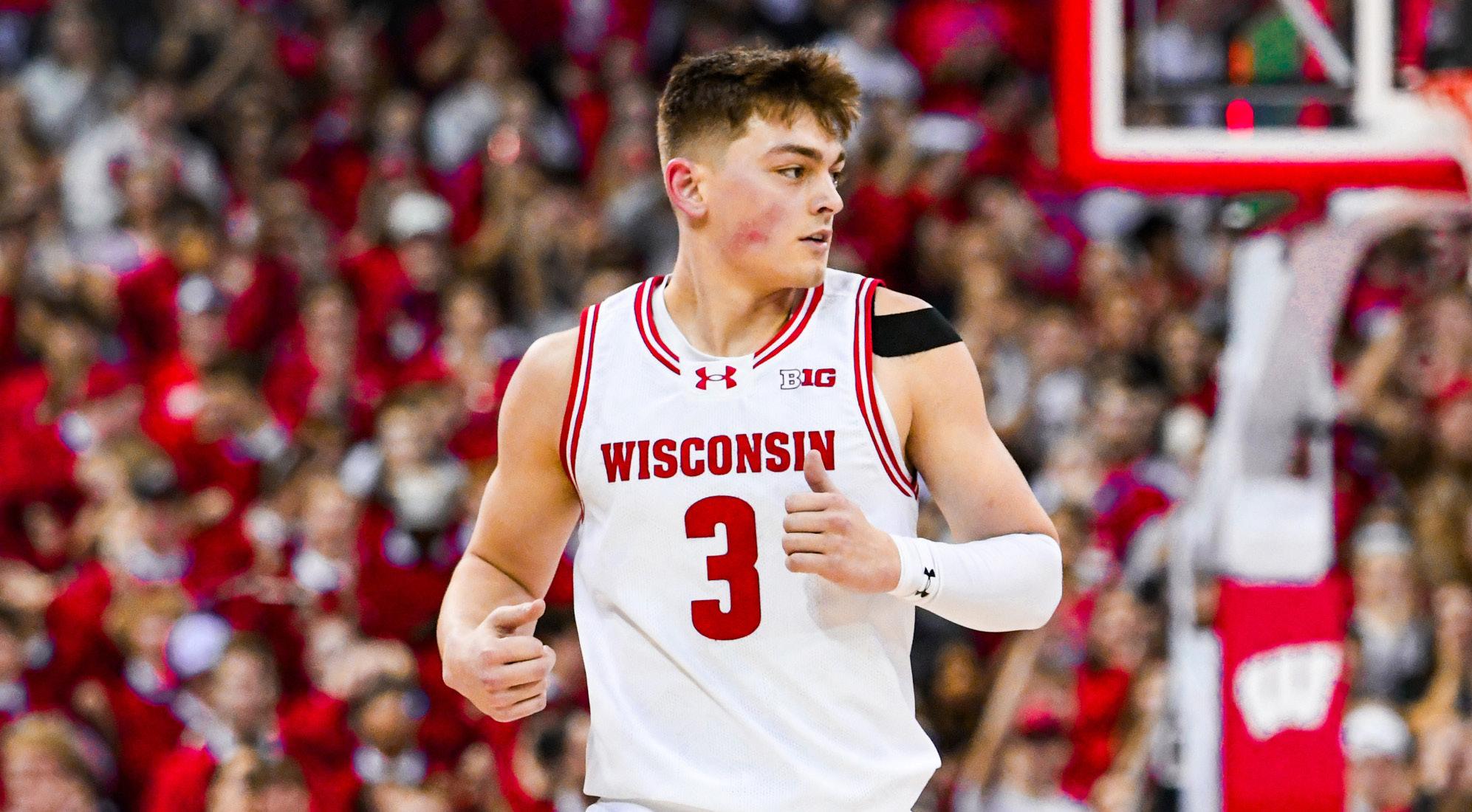 By Jacob Szczap STAFF WRITER
By Jacob Szczap STAFF WRITER
As the Wisconsin Badgers men’s basketball team navigates its way through a tumultuous 2023-24 season, it does so with a big question that still needs to be answered: what should the Badgers do with Connor Essegian?
At this point in the season, head coach Greg Gard largely knows what he’s getting from his players. The Badgers currently sit third in the Big Ten with a 17-9 record (9-6 Big Ten), but with March quickly impending, Wisconsin would certainly like to shore up some of the remaining uncertainties.
In Wisconsin’s 64-52 victory last week over Ohio State, the 6’3 shooting guard was mostly unnoticeable. He played only 10 minutes without recording a stat, encapsulating his diminished role on this year’s team.
It wasn’t always this way. Last season, Essegian was a dynamic playmaker for the Badgers, averaging 27.4 minutes and 11.7 points per game. His 69 3-pointers set a Wisconsin freshman record, paving his way to a spot on the Big Ten All-Freshman team.
This season, he experienced a stark dropoff, averaging 8.1 minutes and 3.6 points per game. So, what happened to Essegian — a player once thought of to be a cornerstone of the future — and where does he go from here?
First, the most obvious reason for Essegian’s drop in playing time this season is that this year’s team is simply better. Newcoming transfers and freshmen provided Wisconsin with much greater depth than last season, creating less room for error. And while Essegian lit up the scoreboard offensively, he still had room for improvement on the defensive end of the floor. With an improved overall roster, Essegian’s defensive limitations became much more noticeable and led to him seeing less time on the floor.
Freshman guard John Blackwell seems to be most responsible for Essegian’s decrease in minutes. Blackwell has averaged 7.7 points per game while displaying a more effective defensive presence.
But even with more difference-making players, Wisconsin still longs for the player they saw last year in Essegian. At his most confident, Essegian scores easily and spaces out the rest of the floor, creating a dynamic no team wants to face.
Essegian demonstrated flashes of positivity even during this year’s down
season. Before Tuesday’s unmotivating showing, Essegian scored a seasonhigh 15 points at Rutgers, proving he is still capable of finding his former self. Yet, by responding to his best game of the season with a 10-minute clunker, Essegian only added to the mystery of how to best utilize him.
Simply increasing his playing time could be Gard’s most viable option to get the most out of Essegian. Last season, Essegian played fewer than 19 minutes just once and became a full-time starter by mid-January.
This season, Essegian’s minutes have essentially flip-flopped — he’s surpassed the 19-minute mark only once. It’s no secret Essegian found more success last year, and more playing time could very well factor into how well he plays.
It may not be a coincidence that Essegian’s best game of the season was the one in which he received a seasonhigh 24 minutes. It isn’t foreign for a player to find success once they’ve found a rhythm, and by supplying their backup shooting guard with more minutes, Wisconsin could benefit from an in-tune Essegian.
Now, of course, there is good reason as to why Essegian has received less playing time. Gard doesn’t bench players without reason. But if there were ever a time to experiment with Essegian, now would be it as Blackwell and backup point guard Kamari McGee are both facing injuries. Gard is already down two backcourt pieces off the bench, so increasing Essegian’s minutes would come at a lower risk.
If Gard opts not to increase Essegian’s workload, then Essegian must figure out how to become a positive differencemaker in the limited opportunities he has. Truly embracing his role as an offthe-bench offensive option could lead to success and eventually force Gard to play him more.
And his defense, while somewhat improved from earlier this season, is still faulty at best. By playing stronger defensively, Essegian could make Gard’s decisions regarding his playing time a lot easier.
Essegian is a player that seems like a missing piece, and his success could be instrumental in how far Wisconsin goes this season. With a top-20 ranking and a four-game losing streak behind them, now is the time for the Badgers to turn up the heat. A flourishing Essegian could make all the difference.

McClellan nominated for prestigious goaltender award
By John Ernst STAFF WRITER
The Hockey Commissioners Association (HCA) announced on Feb. 14 Wisconsin goaltender Kyle McClellan is among10 semifinalists for the prestigious Mike Richter Award, bestowed upon the best NCAA Division I goaltender.
McClellan, a senior in his first season starting for the Badgers, ascended to stardom this season, boasting a .929 save percentage — third-best among goalies in the NCAA — and is also top ten in wins, accruing 20 wins in 29 starts. He’s played the fifth-most minutes of any goalie with 1,711 and allows 1.91 goals a game on average, a huge contribution to a Wisconsin team currently ranked No. 6 in the nation.
Before he was a Badger, McClellan played at Mercyhurst University, transferring after his sophomore season. He is in his second season at Wisconsin, coming off a rough 2022-23 season in which he went 3-6-0 in 12
starts but showing vast improvement this season with a 20-6-1 record. His save percentage has climbed almost 50 points, and he owns an NCAA-leading six shutouts.
Awarded since 2014, the Mike Richter Award is the NCAA top honor for hockey goaltenders, Past winners include Thatcher Demko, the winningest goalie in the NHL this season for the Vancouver Canucks, and Jeremy Swayman, who currently holds the third-highest save percentage in the league for the Boston Bruins.
McClellan earned several other awards this season, including the HCA’s National Goaltender of the Month honors in December and four Big Ten Star Awards this season. He’s also up for the Hobey Baker Award, for the best overall player. Award finalists will be announced on March 20. A Wisconsin player has won the award twice: Cole Caufield in 2020-21 and Blake Geoffrion in 2009-10.
Winners will be announced in April at the Frozen Four national championships in St. Paul, Minnesota.

dailycardinal.com Thursday, February 22, 2024 11 l sports
MEGHAN SPIRITO/THE DAILY CARDINAL
MEGHAN SPIRITO/THE DAILY CARDINAL
MEGHAN SPIRITO/THE DAILY CARDINAL
Style isn’t as simple across the pond: differences in college fashion culture
By Hana Razvi STAFF WRITER
Fashion is universally known as the gateway to the heavens of creativity. Every culture, nation and city has its own spin on what is considered “stylish.” The casual comfort Americans prioritize in fashion vastly contrasts the elegant class displayed in European outfit choices.
In particular, Europeans and Americans each claim superiority in style. Since I started studying abroad in London this past semester, I’ve found the real place where fashion matters: on their university campuses.
Since the rise of the fashion industry in the 19th century, Europeans are credited as the creators of a multitude of luxury brands such as Chanel, Yves Saint Laurent, Gucci and Prada. Their reputation embodies sophistication and elegance, no matter where their destination is. Many European universities and student common areas are filled with blazers, sweaters, trousers and a plethora of accessories to complete each look. Europeans take their outfit choices seriously, and first impressions matter most.
In the United Kingdom, the way people dress often has to do with the British class system. Inherited and generational wealth is a sign of social status and often comes with many perks, such as a cultivated wardrobe. Furthermore, it’s uncommon to see many British students on campus stand out with their outfit choices, as most don’t enjoy standing out in crowds. However, in areas such as Camden Town or Brick Lane — where vintage sourcing, punk rock and street art are abundant — campuses are often filled with funky outfit choices, colored hair and chunky jewelry. These areas have been my most frequented since I landed in the UK due to their variety of people, fashion and food. There is so much life in these two neigh-
A
borhoods, and I am constantly inspired by the culture surrounding them.
American students highly value statement pieces and embrace fashion as a concept that enhances individuality. Those with outlandish fashion choices are seen as “cool” and are stylistically held in high regard. In Europe, people who wear such clothing are often outcasts and looked down upon. The stereotype that Americans are seen as “loud and obnoxious” often comes from their bold outfit choices, and it harms their perception while in common areas like the tube in London or restaurants in downtown Paris. On the other hand, while walking down State Street at the University of Wisconsin-Madison, you’ll find most people wearing sweats and athleisure, especially in cold weather.
However, the few who show up to class in flowy skirts, fuzzy hats, sparkly tops and every piece of jewelry they own are the ones who tend to get the most compliments on their outfits. The effort they put into their appearance despite the temperature are the ones who deservedly get noticed.
In contrast, European women will wear skirts, tights and trousers to class no matter what the weather is outside, and the men never miss a chance to pull out their Sherlock Holmes trench coats and caps. As an American, this is intriguing because they don’t see anything special about dressing up for something as normal as a morning class. It’s simply a part of their culture.
The differences in fashion choices can be attributed to the cultural differences between the two regions. In line with their ability to blend in, Europeans dress simply but elegantly to avoid drawing unwanted attention. It is important to note many American college stu-
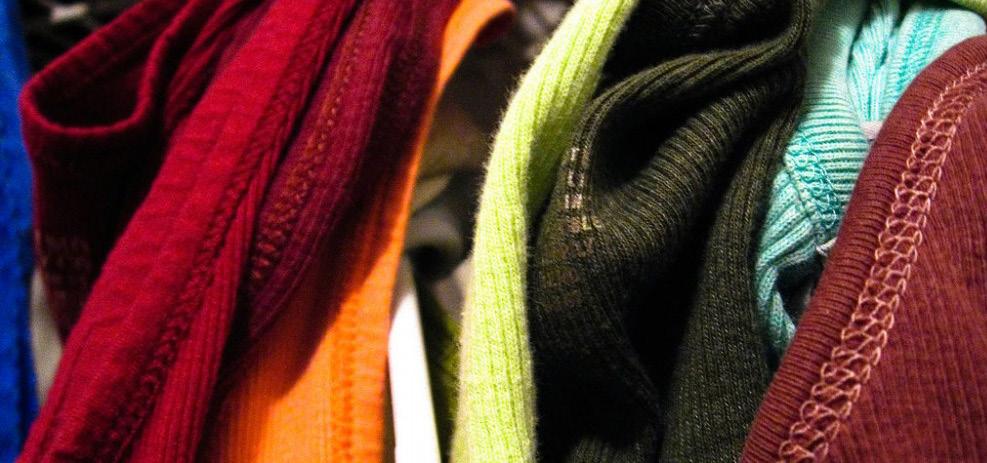
dents who study abroad tend to add timeless pieces to their wardrobe to blend in with the Europeans. Anything from black skirts, trench coats and thick scarves are staples in a secondsemester junior’s suitcase before their flight. I would argue that blending in allows Americans to fully immerse themselves in the country they are studying in. Although Europeans still wear basic and timeless pieces, integration with popularized American trends has brought an entirely new twist. This enhanced style allows Europeans to embrace a familiar aesthetic while introducing more comfortable clothing. Swedish fashion icon and influencer Matilda Djerf can be credited with trending this type of style. Both American and European college women frequent her sustainable clothing brand, Djerf Avenue, which reflects the integration of both styles.
Although Americans value comfort within their style, that does not mean they are limited to athleisure. Many people follow fashion trends beyond the realm of anything remotely comfortable. Unlike in Europe, there is no societal norm about dressing up or down. Fashion inspiration can be taken by anyone from Bella Hadid to Tyler, the Creator. Rapid American fashion trends tend to reflect the ever-changing nature of the country and its desire to live outside of the box. That’s unlike the United Kingdom, a nation rooted in its norms and behaviors.
The best part about fashion is that it’s unique, creative and fully up to each individual who chooses to embrace it. Fashion doesn’t necessarily need labels or to be put into categories divided by different cultures. It should be audacious and valiant. At the end of the day, a person should wear an outfit because they feel good about themselves, regardless of the norm.
denied MacTaggart’s alcohol license change should inspire change in city policy
By Matthew Silletti STAFF WRITER
The Madison Common Council accepted a motion Tuesday to re-refer an alcohol license change for MacTaggart’s Market and Deli back to the Alcohol License Review Committee.
The motion, proposed by District 2 Ald. Juliana Bennett, denied MacTaggart’s attempt to change the restrictions on their alcohol license, something MacTaggart’s has been after since before the start of this school year.
MacTaggart’s, a historic Madison establishment that has been in operation for over 30 years, has seen generations of students walk through its doors. MacTaggart’s has always been a customer-first business, having earned a reputation as a friendly corner store with employees who treat you as family.
That’s why owner and operator Rick Schober said he was motivated to change his alcohol license to better serve customers what they want.
Local governments often move at a snail’s pace and are filled with unexpected potholes, especially regarding alcohol licensing. So why go through the hassle, paperwork and governmental bottlenecks to change your license? For Schober, his customers’ needs will always trump his own.
What are those needs? Hard seltzers.
This might raise some eyebrows if you’ve ever found yourself in MacTaggart’s as they already carry many hard seltzer brands. However, since 2020, new seltzer products have entered the market that are “spirit-based” rather than “maltbased.” This is an issue for MacTaggart’s as the classification of “spirit-based” disallows him from selling these products even though he car-
ries almost identical products in both alcohol percentage and alcohol by volume.
If Schober can’t sell these products, customers will go elsewhere and cost him, his business and his employees money.
“When I have customers come in and say, ‘Oh, do you have High Noon’s?’ and they are going to order a sandwich and chips, they will just leave and go to Riley’s and buy what they actually want,” Schober said during an ALRC meeting.
MacTaggarts currently holds a Class A beer and Class A liquor license. However, condition 5 limits their liquor license to the sale of only wine and cider, disallowing the aforementioned “new” products. During a Jan. 17 meeting of the ALRC, a 5-2 vote struck condition 5 of MacTaggart’s alcohol license, which should have left him in the clear.
However, the Madison Common Council failed to adopt the ALRC’s recommendation onto MacTaggart’s alcohol license during a Feb. 13 meeting.
This outcome might not have been the case had it not been for Michael Donnelly.
Donnelly, a member of the ALRC, was present at the meetings of both the Common Council and ALRC. His testimony, especially during the Common Council meeting, was crucial in prompting a motion for a re-referral back to the ALRC.
“I think we should make a condition that allows this product without allowing everything,” Donnelly said during the Feb. 13 council meeting.
The license change, which would remove MacTaggart’s restriction on selling hard alcohol,
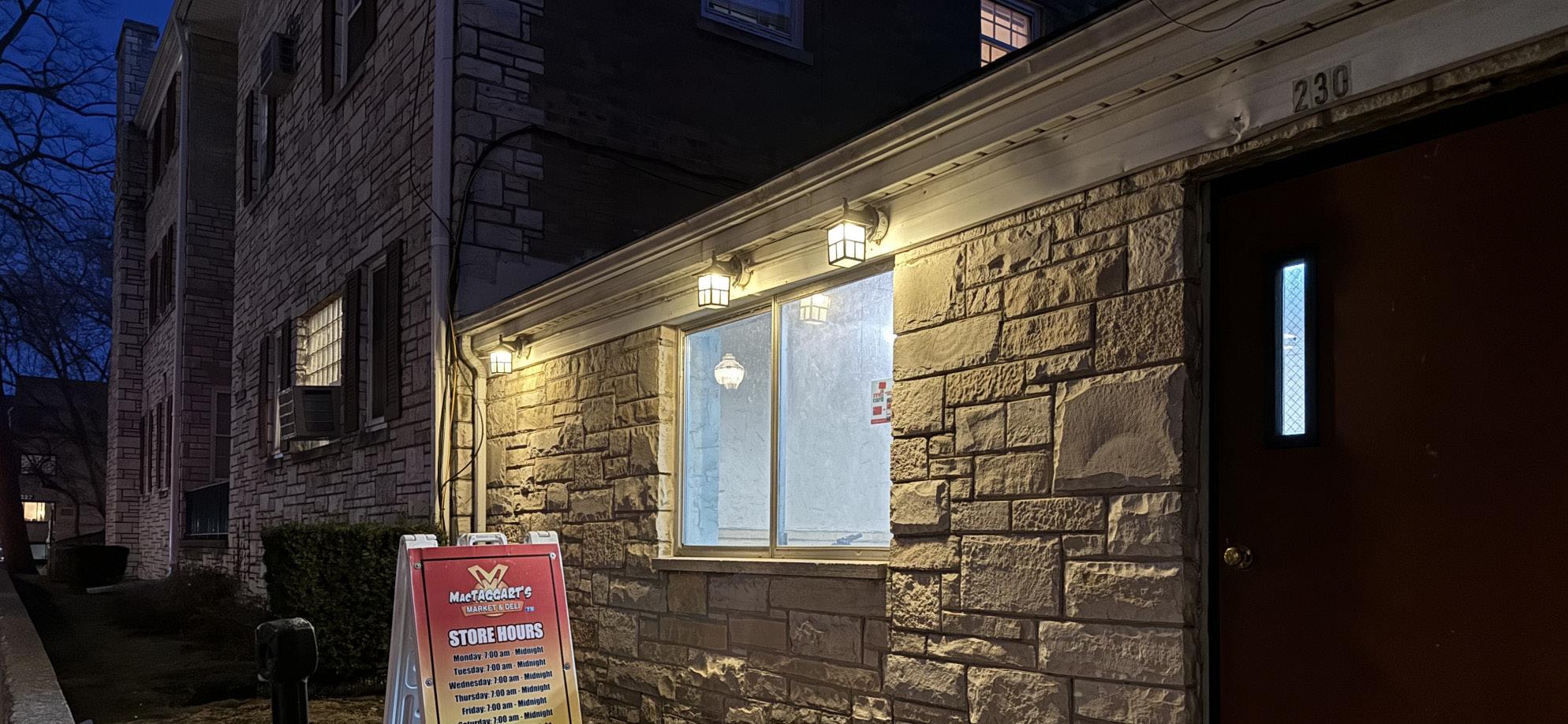
is not what Schober had in mind when he sought to change his license.
“I do not want to become a liquor store, I don’t have the space to backstock and I don’t want to sell handles of vodka or tequila,” Schober said during the ALRC meeting.
Bennett was adamant about her trust in Schober and his intentions not to sell hard liquor.
“It is very clear his intent is to sell spirit-based hard seltzers in single-use cans. His intention is not to sell bottles of alcohol,” Bennett said at the meeting.
Unfortunately for MacTaggart’s, approval on this change will have to wait until after the Common Council receives the new guidelines created by the ALRC to deal with this product category. The council found it prudent to set a standard for these cases and wanted the ALRC to “develop a standard and equitable condition to address the sale of spirit-based hard seltzers.”
“I am confident in sending this back to
the ALRC and that they will make that abundantly clear along with his (Rick’s) intentions,” Bennett said.
Donnelly was a crucial figure in the outcome of this decision, repeatedly stressing why allowing the change on the restriction would set a poor example going forward. He said he fears lifting the restriction under the promise that the establishment won’t sell hard alcohol — something Schober has been vehemently adamant about — is not a good way of doing business.
“I think that saying we don’t want somebody to do this, but we are going to give them a license saying they can anyway because we trust them not to use it is not a good idea,” Donnelly said.
The ALRC will discuss and craft specific guidelines for dealing with this particular product category at a Feb. 21 meeting. Until then, MacTaggart’s will have to wait even longer in a process already claiming months of Schober’s time and countless potential sales.
opinion 12 Thursday, February 22, 2024 dailycardinal.com l
COURTESY OF FLICKR/VIA CREATIVE COMMONS BritishandEuropeanuniversityfashionisawholeotherballpark.
SILLETTI/DAILY CARDINAL
PHOTO
MATTHEW
life & style

How to maintain a balanced, healthy lifestyle
By Alexandra Malatesta STAFF WRITER
Balancing and maintaining a healthy lifestyle is something many people strive for — and in the last few months, I think I’ve nailed it.
There is so much more to the concept of “having a healthy lifestyle.” It’s about the small changes in your day that not only feel good in the moment but are easy to maintain, and with time can change your perspective or alter your mood in a positive way.
Staying with a concept that is consistent isn’t as easy as it may sound, but it’s not unattainable. I’ve used my experience to alter my habits and learn what works for me, so I want to share some simple tips that may also work for you.
Do it for yourself
You should maintain a healthy lifestyle for no one but yourself. Don’t set a goal. Don’t set a number. Start fresh and alter small daily tasks until you physically feel better. Never weigh yourself — the whole point about having a healthy lifestyle is to feel better, and once you begin to feel better, that means it’s working.
Keep your space clean
Although this sounds like an obvious one, taking the time to do a deep clean can be exhausting — half the time, that exhaustion is the reason our rooms and space get too messy in the first place. Motivate yourself to spend a day cleaning, then clean up after yourself as you move into the future. Many small cleans feel much better and less exhausting than one big clean, and it helps prevent a mess from building up.
Finish your tasks completely
Go fold that pile of clothes on the floor that you pulled out from the dryer. Yes, you took the time to do your laundry, but finish the task and make sure you follow through.
Establish a workout routine
There is a lot to unpack here. I’m not asking you to go to the gym, consume an ungodly amount
Everything in moderation
By Hallie Albert STAFF WRITER
How is trying to figure out a healthy, realistic daily routine more stressful than the routine itself?
Social media has enabled us to upload edited “daily routines,” creating intense comparison and a lack of reality for the rest of the world to see. Apps like Instagram, TikTok and YouTube allow users to create edited videos and photos for the world to see. Authors and therapists publish self-help books promising direct changes if you follow their routine, but no individual human brain is the same. There is not one routine, study habit nor piece of advice that will make us all equally productive and motivated.
an all-or-nothing approach to daily life. Consumers are spoon-fed health habits guaranteed to make us happy, productive and successful. Don’t you want these things?
It’s easy to wake up at the crack of dawn, juice a lemon into warm water, complete a workout and eat “clean” food. But be sure to also prioritize school and go to bed early.
We may actually be doing more harm to ourselves than good. It feels like the world needs to take a deep breath. What about our favorite foods? What about our social lives?
What about relaxation? I believe in the phrase, “everything in moderation,” and you should too.
ing balance can be. You would be surprised how much you already know.
We all need eight hours of sleep or more to increase memory and mood, exercise to help with serotonin levels and nutritious foods to keep us healthy.
A piece of pizza is not nutritious, it is heavy on carbs and grease. Here is my take: even though a slice of pizza is unhealthy, it could be a source of happiness. Pizza everyday may not be the right choice for most people, but if this piece of pizza — or whatever food you prefer — creates enjoyment and helps you stay motivated to keep going, then eat it. This can be said with many things like TV or social media as well.
of pre-workout or protein powder, and become a gym rat — that works for some but not all.
Start by just walking. Plug in your headphones, put on your favorite podcast and walk. Just walk. Start by implementing a good walk into your day, then go about a strengthening workout routine. Get consistent and build from there. What works for me is a workout class. The gym isn’t for me, but I can stay motivated with other people in the room. The most essential part of building a new routine is to stay consistent. Working out in some form at least three -to- four times a week for two months will change your life, and you will see progress.
Start to eat at home more
Utilize the kitchen you have access to. Start making grocery shopping and meal prep fun. Social media has tons of recipes that are easy to make, and places like Trader Joe’s make it affordable.
Don’t limit yourself too much
Don’t restrict yourself, but don’t go crazy. For example, this summer I cut out all fast food and fried food from my diet — but that didn’t mean ice cream was off the table. I still make sure that I can go on ice cream runs with my friends or bake cookies with my brothers. Just have smaller portions, which will still itch the craving and make you feel better post-meal.
Don’t compare yourself
This is a basic one, but it’s difficult in the age of social media to avoid comparing yourself to others. Sometimes this can make you feel like you aren’t good enough or worthy of being able to live a healthy and balanced lifestyle, but you are. Everyone’s journey is unique — and guess what, you get to personalize yours. Enjoy it, and remember you are in the driver’s seat of your own body.
I hope these tips at least get you thinking and will hopefully impact you in a small way. These changes are doable, so stay consistent and motivate yourself. Do it for you.
In today’s world — especially as a college student — there are extreme pressures and unrealistic expectations put on individuals to live a “perfect life.” However, these routines are specially curated for the internet to see and rarely scientifically proven. Despite the facts, followers compare and contrast their lives to what they see online daily.
“Constant comparison when people are scrolling is what is believed to lead to harm,” the American Medical Association wrote in a 2021 report. The report found harm includes “body-image issues, body dysmorphia and often comparisons of success in life.”
I want you to think of this the next time you encounter one of these posts. Social media adds many positive aspects to our society — it has changed the way the world communicates with one another, allowing for immediate messages and calls. Yet, it is important to be educated and aware when using social media in order to live a fulfilling and happy life.
It feels as if the competition to be the busiest, most productive person has turned into
Let’s say you do decide to follow a strenuous routine. You make yourself get out of bed at 6 a.m., force yourself to say no to friends and family, strictly prioritize unrealistic goals, cut out your favorite foods and spend your free time only studying or reading. These are great habits to add into your life, but you are going to burn out if you do not give yourself room for enjoyment.
I want to encourage you to make a personalized yet realistic routine. If routines are not your thing, maybe just gradually implement new habits into your life. You are your biggest advocate and know yourself best, so let’s get realistic. As college students, we need habits and routines that allow us a few hours of free time or to enjoy a burger with friends — a routine that allows us to live.
I have listened to many seminars drilling so-called “healthy habits” into my brain throughout middle school, high school and even college, and I am sure you have too. Therefore, you may already know all the facts in order to live a healthy lifestyle. Either way, I want to reiterate how simple implementing healthy habits while keep-
Although not all habits are extremely productive, some “unproductive” habits can be necessary. Not everything needs to be productive in order to be healthy.
I hope reading this article feels like a breath of fresh air or lifts some weight off your shoulders. Waking up at 2 p.m. is okay sometimes. Eating fried food is okay. And it is certainly okay to have a lazy day.
Cutting out these habits can be unhealthier than indulging in moderation every once and while.
From personal experience, creating and implementing simple, healthy habits — such as eight hours of sleep, exercising three times a week and eating well — can be helpful, but don’t be afraid to start small and work your way up.
Sadly, there is no quick fix or step-by-step checklist ensuring you will have a productive satisfying routine. I can recommend taking some time to think about what works for you and your lifestyle. Stop thinking of all the things you could be doing, and just start doing. You do not have to be perfect.

dailycardinal.com Thursday, February 22, 2024 l 13
Struggling to maintain a healthy lifestyle? Give these tips a try.
DRAKE WHITE-BERGEY/THE DAILY CARDINAL
Overwhelmed by conflicting ways to incorporate routine into your daily life? Try everything in moderation. MAILE LLANOS/THE DAILY CARDINAL
the beet l Madison to use new measurement system named after Alder MGR
By Omar Waheed THE BEET EDITOR
Madison will adopt a new system of measurement method inspired by a campus-area alder.
New considerations on how to measure the size of developments in a way that’s more relatable to the average Madisonian have been introduced this week. The new measurement, named after District 8 Alder MGR Govindarajan, is based on his height and dubbed an “M-MGR,” or metric MGR.
“I’m not sure if I’d want to be the unit of measurement here,” Govindarajan told The Daily Cardinal.
One M-MGR equates to 65 inches, 1.81 yards, 0.001 miles or 0.00089 nautical miles for the U.S. imperial measurement system. For metrics, one M-MGR is 165.1 centimeters, 1.651 meters or 0.001651 kilometers.
A height ordinance passed in 1966 restricts buildings within one mile of the state Capitol to be no taller than the Capitol’s pillars. At 187 feet, this equates to 34.52 M-MGRs.
To scale for planned developments, like the North-South Bus Rapid Transit, the new route is roughly 3,400 M-MGRs.
Looking at housing developments, Core Spaces’ planned 15-story “Johnson and Broom” student housing development clocks in at approximately 162.4 feet, which is 29.98 M-MGRs.



Return of the redlines: Wisconsin Republicans
silently celebrate victory with new legislative maps
By Omar Waheed THE BEET EDITOR
Redlining returns as Wisconsin Republicans have reversed course on stance against new maps after they realized it brings back 1900s segregation — which was their plan all along.
On Monday, Feb. 20, Democratic Gov. Tony Evers signed new legislative maps after months of contention between Democrats and Republicans.
After looking at the new maps, state Republicans have fallen silentto celebrate after Democrats once again gave them exactly what they wanted without working for it.
“These new maps are a victory — not for any political party, but for our
state and for the people of Wisconsin, who have spent a decade demanding more and demanding better from their elected officials,” Evers said in a tweet celebrating the achievement. “This is a game-changing moment that will define our state’s future.”
Assembly Speaker Robin Vos, R-Rochester, responded with a crying laugh emoji under the Evers’ tweet before quickly deleting it.
Vos, after failures to impeach new liberal Supreme Court Justice Janet Protasiewicz, decided to switch course and let Democrats do what they do best: supporting Republicans.
State Democrats have, once again, said parties need to come together to fix the problem they caused.
“We must see each other not as enemies, but as fellow Americans,” Evers said.
Changes in the maps have garnered mixed results from Wisconsinites. One local Milwaukee north side resident didn’t notice any changes.
One white Madisonian, who identified himself as a liberal, has shown his excitement for the new legislative maps. He’s excited to see property values increase.
“I like the maps,” the Madison resident said. “It’s about time they change the lines to stop busing other children to my child’s school.”
Democrats, now realizing the mistake, are now sending emails to voters for campaign donations to change maps again.
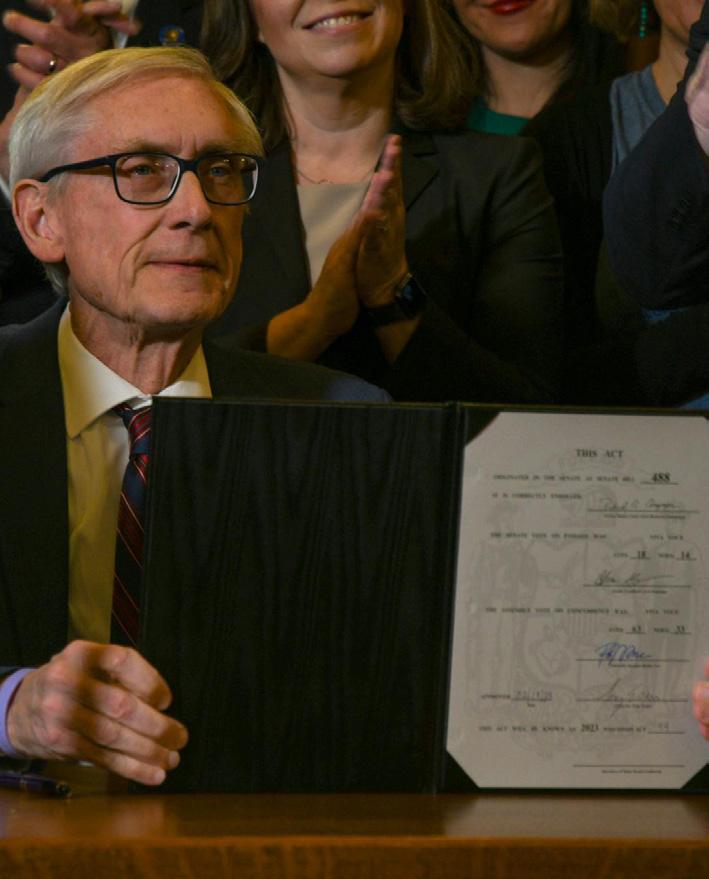
14 Thursday, February 22, 2024 dailycardinal.com
OMAR WAHEED/THE DAILY CARDINAL
MARY BOSCH/THE DAILY CARDINAL
OMAR
WAHEED/THE DAILY CARDINAL
Free Palestine activism: On the walls & on the streets


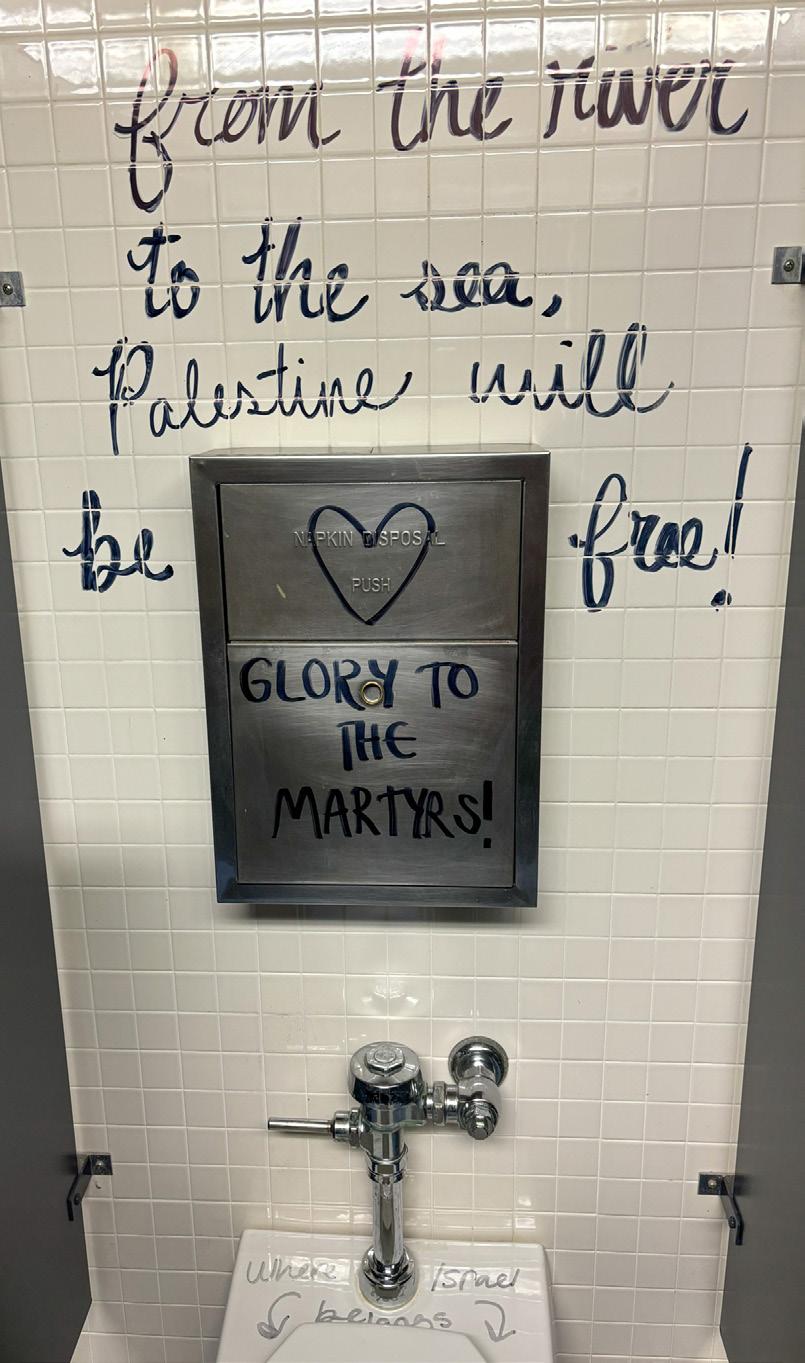


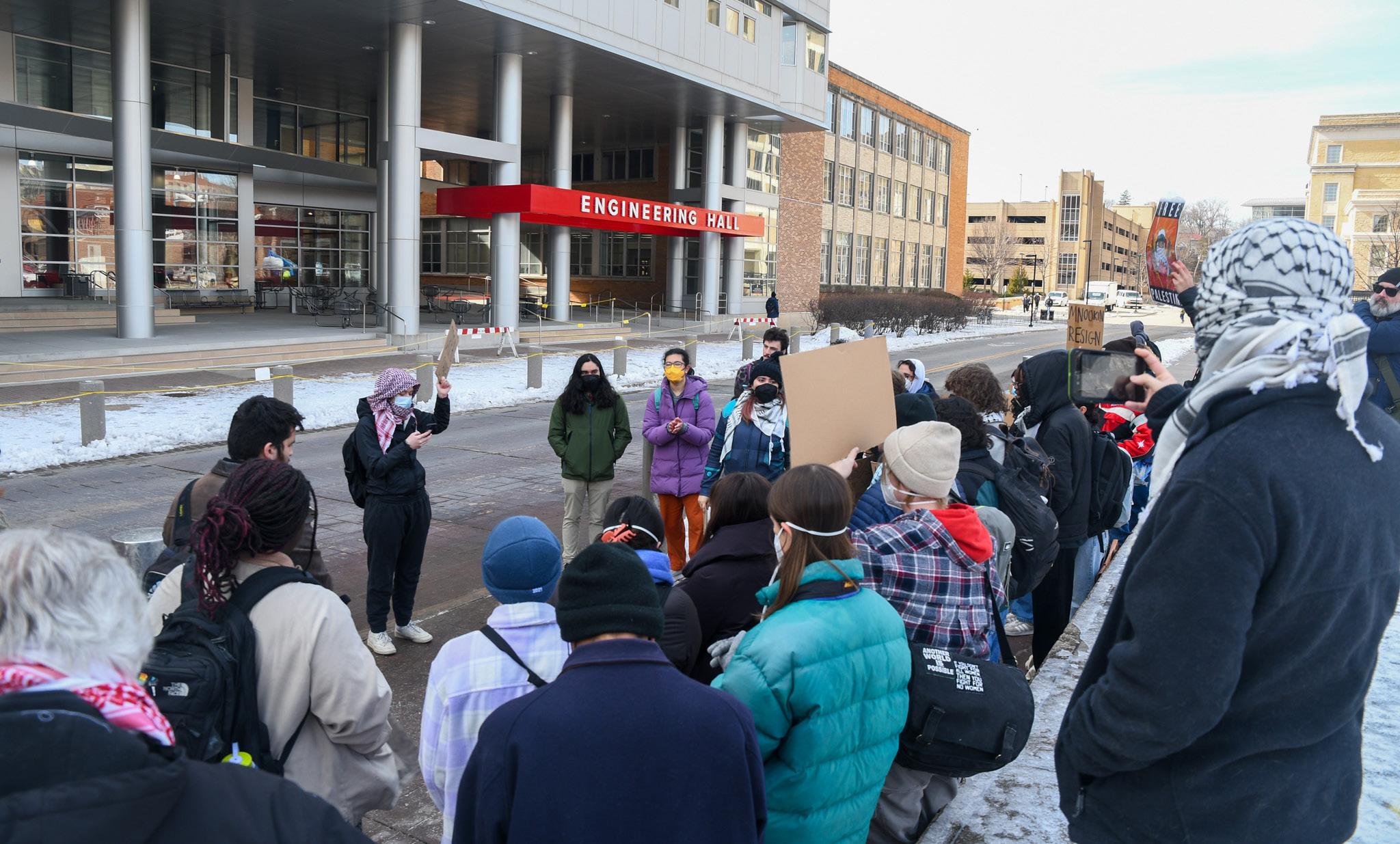
Thursday, February 22, 2024 15
snapper’s row
Students protest UW-Madison's involvement with weapons manufacturers outside the Engineering Hall on Feb. 19, 2024.
DAILY
dailycardinal.com l
MARY BOSCH/THE
CARDINAL
MARY BOSCH/THE DAILY CARDINAL
A sign displaying "Resistance is justified when people are occupied" is displayed on the Liminology Building on Lakeshore Path on Feb. 20, 2024.
MARY BOSCH/THE DAILY CARDINAL
Humanities sixth floor
DAILY CARDINAL
"Free Palestine" is written on a bathroom wall in Mosse Humanities Building on Feb. 19, 2024.
Pro-Palestinian graffiti
is displayed in Mosse
women's bathroom. ANNA KLEIBER/THE
Students listen to a speaker from Mecha De UW-Madison list their demands for the university during a protest against UW-Madison’s involvement with weapons manufacturers outside the Engineering Hall on Feb. 19, 2024.
BOSCH/THE DAILY CARDINAL
MARY
Former UW-Madison Vietnam War protestor Frank Emspak speaks to students about the importance of student activism on Feb. 19, 2024.
DAILY
MARY BOSCH/THE
CARDINAL

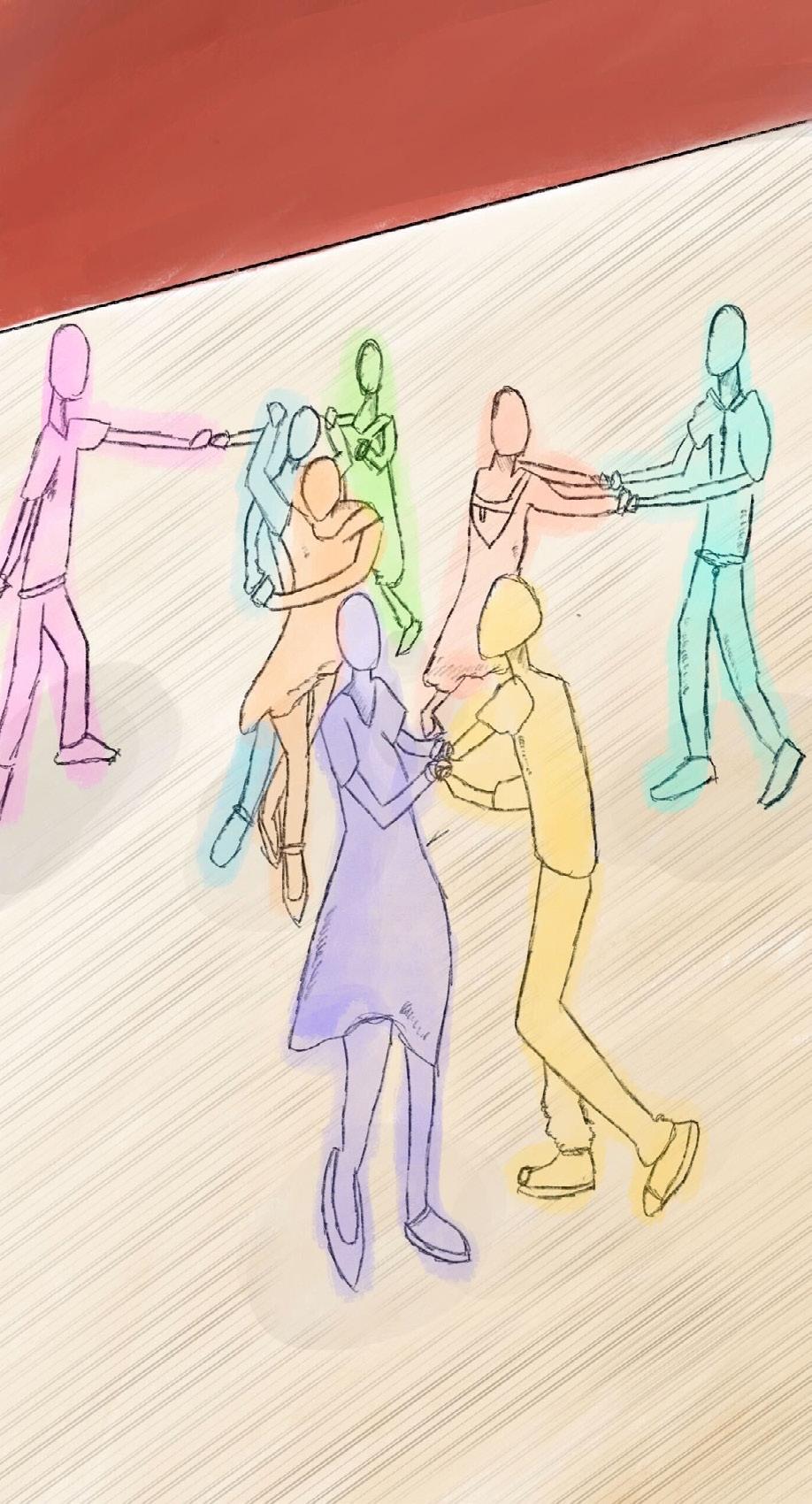
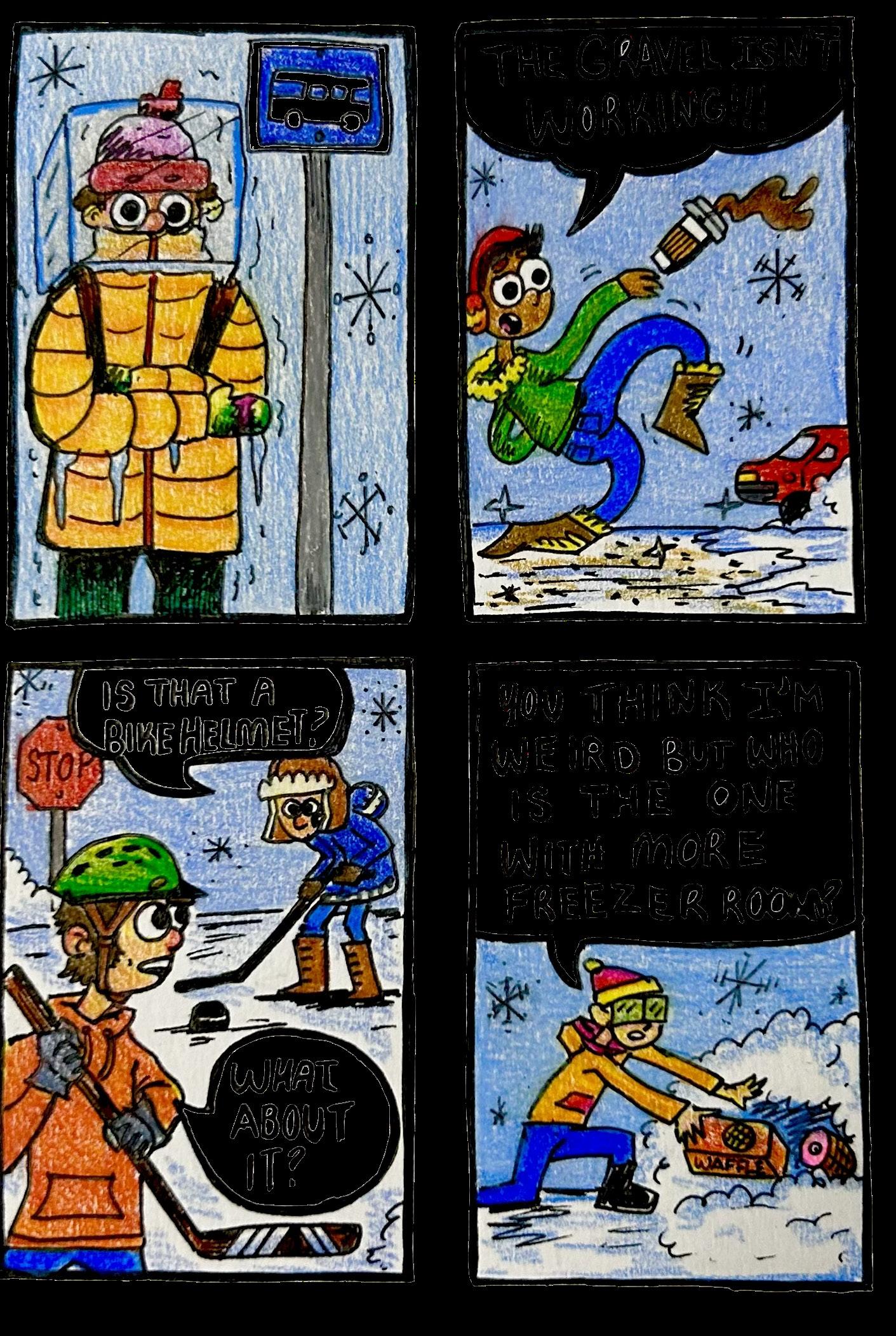
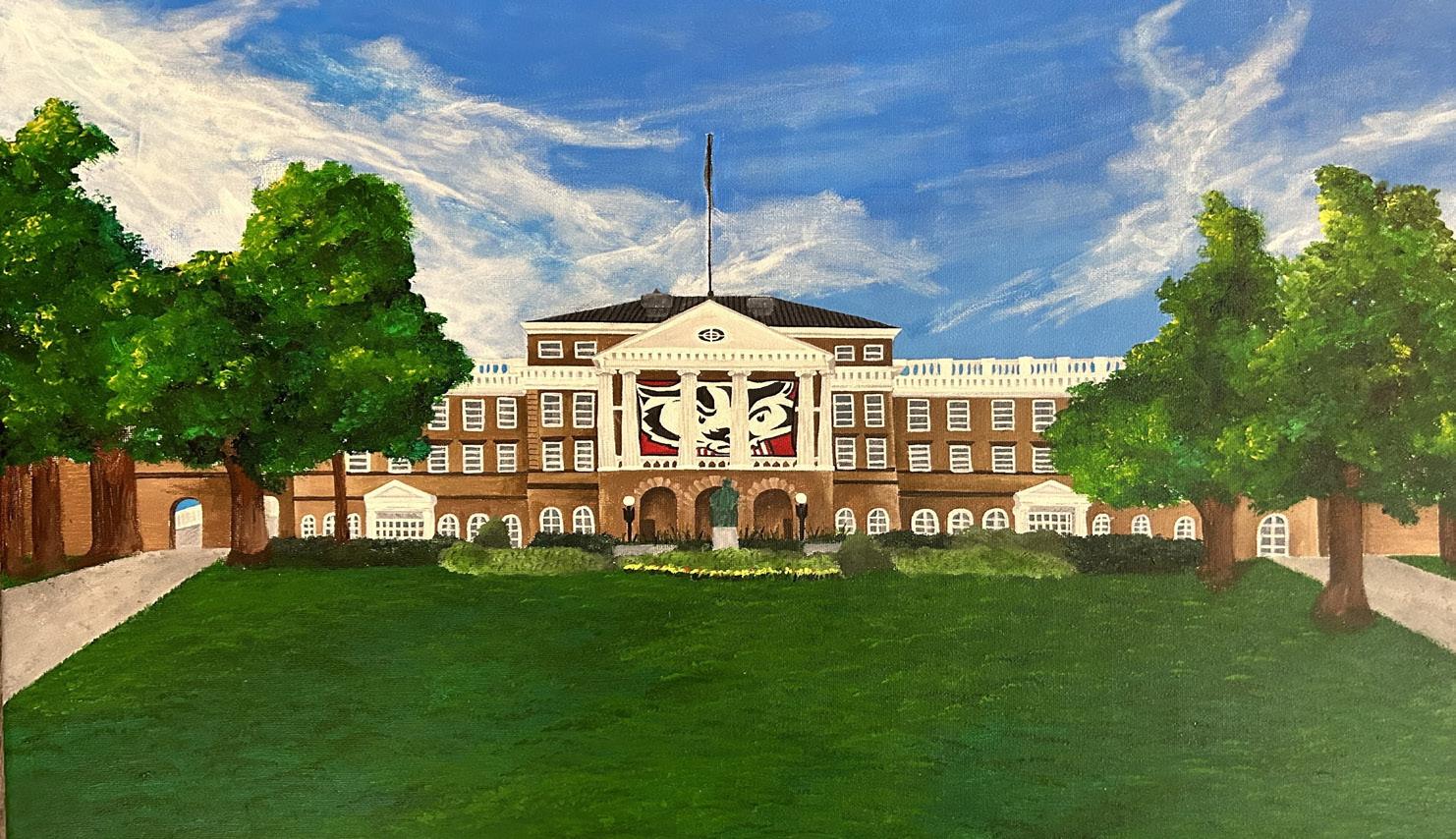
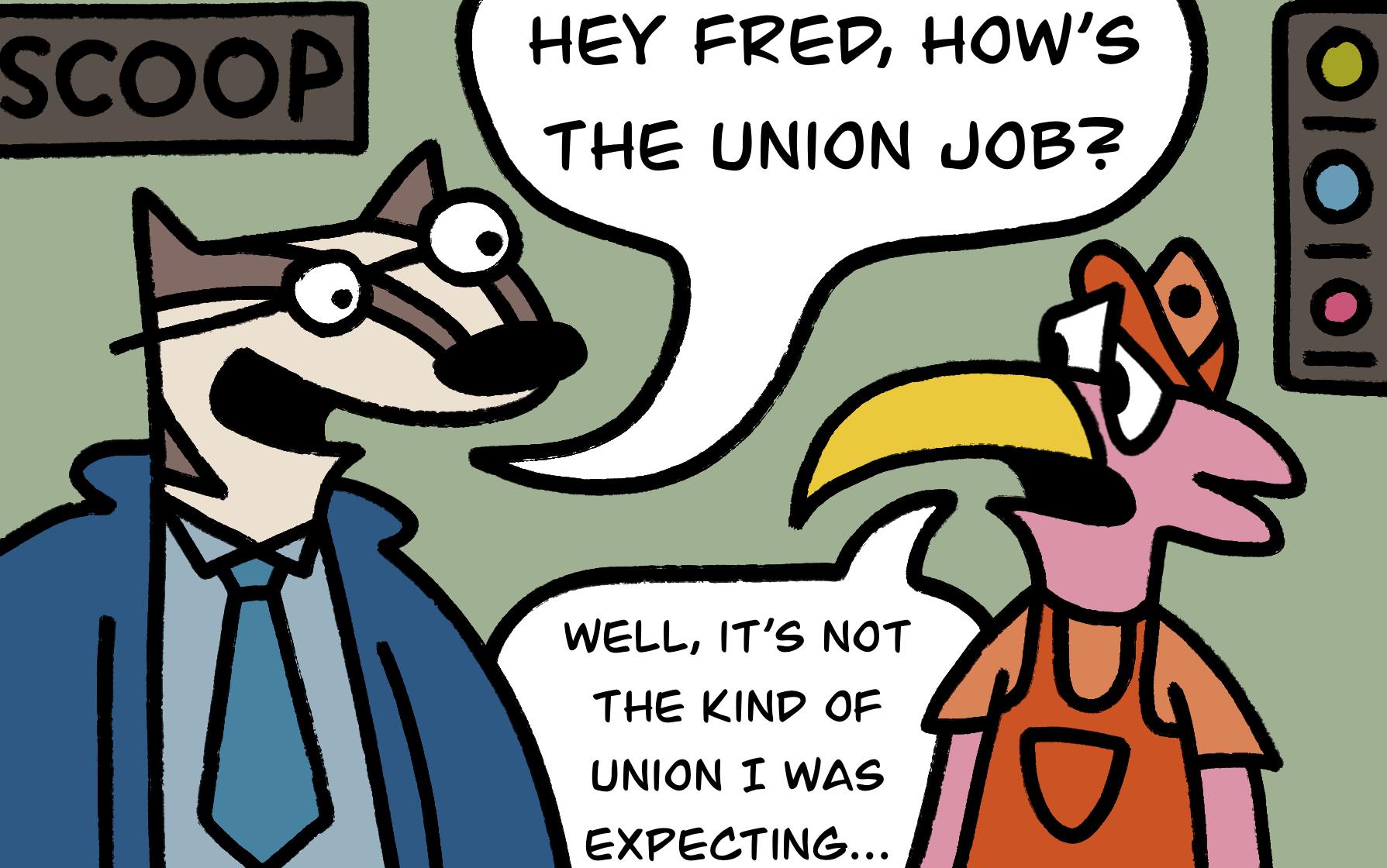

comics 16 • Thursday, February 22, 2024 dailycardinal.com
Winter Trudge
River Kratochvil
The Streets
Hailey Johnson
Bascom Buddies
Henry A. Moore
Good Ol’Fashioned Wisconsin
Paige Stevenson
Take a Swing At Dance Liam Beran
Bascom Hill
Ava Hayes




















 By Anna Kleiber ARTS EDITOR
By Anna Kleiber ARTS EDITOR


 By Lindsay Pfeiffer STAFF WRITER
By Lindsay Pfeiffer STAFF WRITER













 By Jacob Szczap STAFF WRITER
By Jacob Szczap STAFF WRITER





















